-
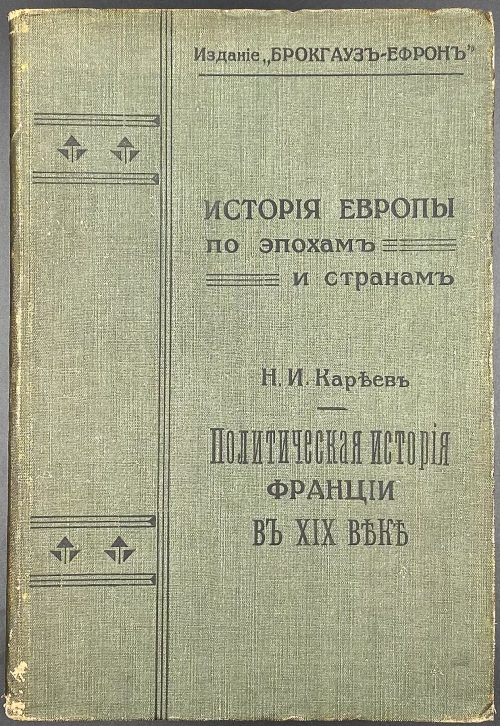 Cover: Изданiе "БРОКГАУЗЪ-ЕФРОНЪ" | ИСТОРIЯ ЕВРОПЫ | ПО ЭПОХАМЪ | И СТРАНАМЪ | Н. И. Карѣевъ | ПОЛИТИЧЕСКАЯ ИСТОРIЯ | ФРАНЦIИ | ВЪ XIX ВѢКѢ || Title page: Исторiя Европы по эпохамъ и странамъ в среднiе вѣка и новое время. | Изд. под. ред. Н. И. Карѣева и И. В. Лучицкаго. | Н. И. КАРѢЕВЪ | ПОЛИТИЧЕСКАЯ | ИСТОРIЯ ФРАНЦIИ | ВЪ XIX ВѢКѢ. | (Правительственныя формы и внутренняя политика, политическiя партiи | и общественные классы). | Изданiе Акц. Общ. "Брокгаузъ-Ефронъ". | С.-ПЕТЕРБУРГЪ. | Типографiя Акц. Общ. Брокгаузъ-Ефронъ. Прачешный пер. № 6. | 1902. || Pagination: [2] – title / blank, [i-iii] iv-v [vi], [1] 2-300 +1 colour plate (maps). Collation: 8vo; [π]4 1-188 196 + 1 leaf (maps). Binding: Publisher’s green cloth with black lettering to spine and cover, design elements to cover. Contributors: Кареев, Николай Иванович (Russian, 1850 – 1931) – author.
Cover: Изданiе "БРОКГАУЗЪ-ЕФРОНЪ" | ИСТОРIЯ ЕВРОПЫ | ПО ЭПОХАМЪ | И СТРАНАМЪ | Н. И. Карѣевъ | ПОЛИТИЧЕСКАЯ ИСТОРIЯ | ФРАНЦIИ | ВЪ XIX ВѢКѢ || Title page: Исторiя Европы по эпохамъ и странамъ в среднiе вѣка и новое время. | Изд. под. ред. Н. И. Карѣева и И. В. Лучицкаго. | Н. И. КАРѢЕВЪ | ПОЛИТИЧЕСКАЯ | ИСТОРIЯ ФРАНЦIИ | ВЪ XIX ВѢКѢ. | (Правительственныя формы и внутренняя политика, политическiя партiи | и общественные классы). | Изданiе Акц. Общ. "Брокгаузъ-Ефронъ". | С.-ПЕТЕРБУРГЪ. | Типографiя Акц. Общ. Брокгаузъ-Ефронъ. Прачешный пер. № 6. | 1902. || Pagination: [2] – title / blank, [i-iii] iv-v [vi], [1] 2-300 +1 colour plate (maps). Collation: 8vo; [π]4 1-188 196 + 1 leaf (maps). Binding: Publisher’s green cloth with black lettering to spine and cover, design elements to cover. Contributors: Кареев, Николай Иванович (Russian, 1850 – 1931) – author. -
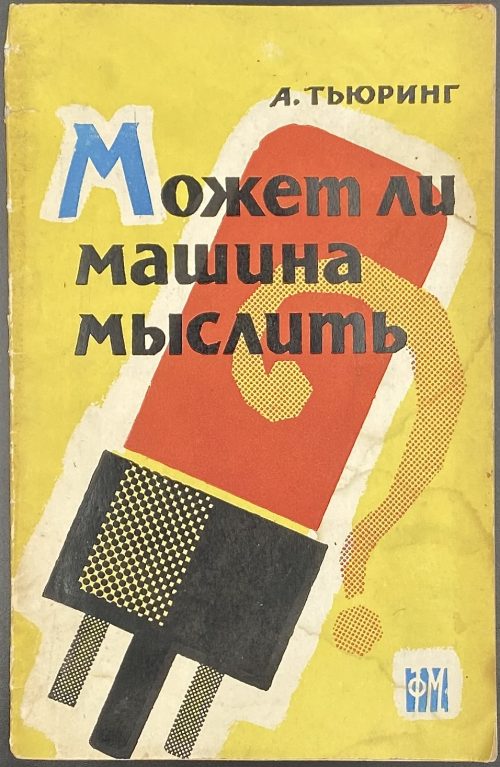 А. Тьюринг. Может ли машина мыслить? / С прил. ст. Дж. фон Неймана "Общая и логическая теория автоматов"; пер. с англ. Ю. А. Данилова; ред. и пред. С. А. Яновской. — М.: Физматгиз, 1960. Title page: А. ТЬЮРИНГ | МОЖЕТ ЛИ | МАШИНА МЫСЛИТЬ? | С приложением статьи ДЖ. фон НЕЙМАНА | ОБЩАЯ И ЛОГИЧЕСКАЯ ТЕОРИЯ АВТОМАТОВ | Перевод с английского | Ю. А. Данилова | Редакция и предисловие | проф. С. А. Яновской | {Publisher’s device «ФМ» | ГОСУДАРСТВЕННОЕ ИЗДАТЕЛЬСТВО | ФИЗИКО-МАТЕМАТИЧЕСКОЙ ЛИТЕРАТУРЫ | МОСКВА 1960 || Pagination: [2] 3-110 [2]. Collation: [1]8, 2-416; 11 (t.p./contents, imprint.) unsigned. Size: 20 x 13 cm Binding: Softcover, front pictorial wrapper – yellow background and radio lamp, lettering: А. Тьюринг. Может ли | машина | мыслить | ? | {publisher's device white on blue "ФМ"} || Contributors: Turing, Alan Mathison (British, 1912 – 1954) – author of the text. John von Neumann (American-Hungarian, 1903 – 1957) – author of the text. Данилов, Юлий Александрович (Russian, 1936 – 2003) – translator. Яновская [Неймарк], Софья Александровна (Russian-Jewish, 1896 – 1966) – author of preface, editor.
А. Тьюринг. Может ли машина мыслить? / С прил. ст. Дж. фон Неймана "Общая и логическая теория автоматов"; пер. с англ. Ю. А. Данилова; ред. и пред. С. А. Яновской. — М.: Физматгиз, 1960. Title page: А. ТЬЮРИНГ | МОЖЕТ ЛИ | МАШИНА МЫСЛИТЬ? | С приложением статьи ДЖ. фон НЕЙМАНА | ОБЩАЯ И ЛОГИЧЕСКАЯ ТЕОРИЯ АВТОМАТОВ | Перевод с английского | Ю. А. Данилова | Редакция и предисловие | проф. С. А. Яновской | {Publisher’s device «ФМ» | ГОСУДАРСТВЕННОЕ ИЗДАТЕЛЬСТВО | ФИЗИКО-МАТЕМАТИЧЕСКОЙ ЛИТЕРАТУРЫ | МОСКВА 1960 || Pagination: [2] 3-110 [2]. Collation: [1]8, 2-416; 11 (t.p./contents, imprint.) unsigned. Size: 20 x 13 cm Binding: Softcover, front pictorial wrapper – yellow background and radio lamp, lettering: А. Тьюринг. Может ли | машина | мыслить | ? | {publisher's device white on blue "ФМ"} || Contributors: Turing, Alan Mathison (British, 1912 – 1954) – author of the text. John von Neumann (American-Hungarian, 1903 – 1957) – author of the text. Данилов, Юлий Александрович (Russian, 1936 – 2003) – translator. Яновская [Неймарк], Софья Александровна (Russian-Jewish, 1896 – 1966) – author of preface, editor. -
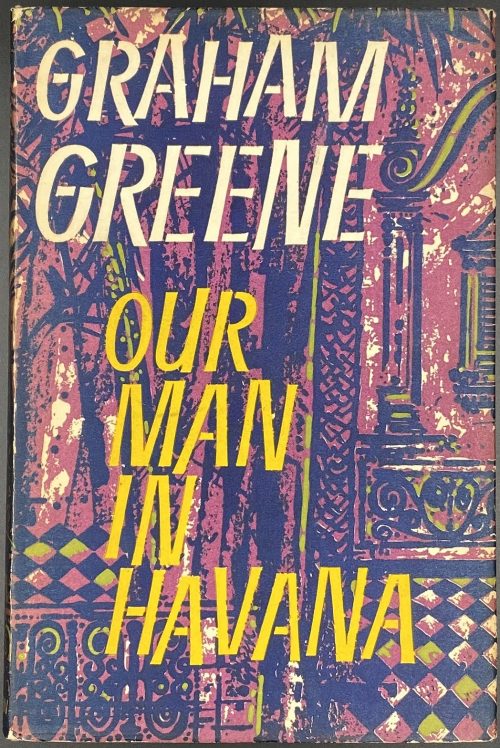 Title page: GRAHAM GREENE | {double rule} | Our Man in Havana | AN ENTERTAINMENT | {publisher’s device: windmill among the hills, letters W and H} | HEINEMANN | LONDON MELBOURNE TORONTO || Title verso: William Heinemann Ltd | LONDON MELBOURNE TORONTO | CAPE TOWN AUCKLAND | THE HAGUE | First published 1958 | © by William Heinemann Limited 1958 | All rights reserved | Printed in Great Britain | at The Windmill Press | Kingswood, Surrey || Pagination: [6] [1, 2] 3-273 [274]. Binding: 20.2 x 13.5 cm, publisher’s blue cloth, gilt lettering to spine (top): OUR | MAN | IN | HAVANA | {double rule} | GRAHAM GREENE | (bottom): HEINEMANN ||; blind-stamped publisher’s device to back cover in the lower-right corner without lettering; pp. 1-122 and 253-274 darker, than the middle pages; original dust jacket designed by Donald Green, unclipped, 15s NET in the lower-right corner of the front flap, advertisement of The quiet American on the back. Edition: 1st edition, 1st printing. Contributors: Graham Greene (British, 1904 – 1991) – author. Donald Green (British, 1919 – 1983) – DJ artist. William Henry Heinemann (British-Jewish, 1863 – 1920); William Heinemann Limited – publisher. The Windmill Press (Kingswood, Surrey) – printer.
Title page: GRAHAM GREENE | {double rule} | Our Man in Havana | AN ENTERTAINMENT | {publisher’s device: windmill among the hills, letters W and H} | HEINEMANN | LONDON MELBOURNE TORONTO || Title verso: William Heinemann Ltd | LONDON MELBOURNE TORONTO | CAPE TOWN AUCKLAND | THE HAGUE | First published 1958 | © by William Heinemann Limited 1958 | All rights reserved | Printed in Great Britain | at The Windmill Press | Kingswood, Surrey || Pagination: [6] [1, 2] 3-273 [274]. Binding: 20.2 x 13.5 cm, publisher’s blue cloth, gilt lettering to spine (top): OUR | MAN | IN | HAVANA | {double rule} | GRAHAM GREENE | (bottom): HEINEMANN ||; blind-stamped publisher’s device to back cover in the lower-right corner without lettering; pp. 1-122 and 253-274 darker, than the middle pages; original dust jacket designed by Donald Green, unclipped, 15s NET in the lower-right corner of the front flap, advertisement of The quiet American on the back. Edition: 1st edition, 1st printing. Contributors: Graham Greene (British, 1904 – 1991) – author. Donald Green (British, 1919 – 1983) – DJ artist. William Henry Heinemann (British-Jewish, 1863 – 1920); William Heinemann Limited – publisher. The Windmill Press (Kingswood, Surrey) – printer. -
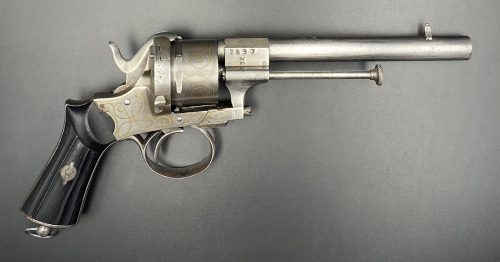 Serial number 8697, barrel 14.5 cm, calibre 9 mm Lefaucheux M-1858 double-action pin-fire revolver manufactured in the late 1860-s. Produced in France with no retailers marking but having French proofs on front of the cylinder and right side of barrel trunnion. The metal remains in the white with small gold wire inlays. Fluted 2 piece ebony grips. This pattern has been observed in civil war photographs and excavated from battlefields and camps in the United States. Dimensions: L: 25 cm; H: 13 cm; Barrel: 14.5 cm.
Serial number 8697, barrel 14.5 cm, calibre 9 mm Lefaucheux M-1858 double-action pin-fire revolver manufactured in the late 1860-s. Produced in France with no retailers marking but having French proofs on front of the cylinder and right side of barrel trunnion. The metal remains in the white with small gold wire inlays. Fluted 2 piece ebony grips. This pattern has been observed in civil war photographs and excavated from battlefields and camps in the United States. Dimensions: L: 25 cm; H: 13 cm; Barrel: 14.5 cm. -
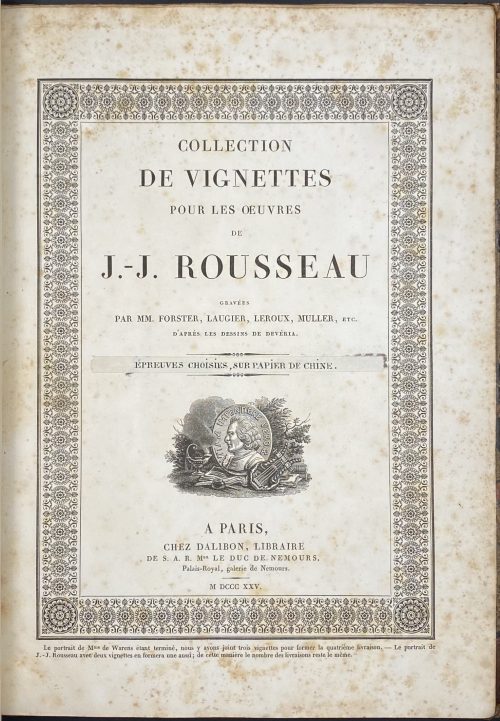 Pictorial album of 41 etchings, incl. two portraits, by various engravers after Achille Devéria, printed on India paper (after letters) and pasted on thick wove paper, bound with tissue guards in half calf over marbled boards bordered gilt, spine decorated gilt, marbled endpapers; base paper and tissue guards are substantially foxed, images mostly intact. The title page and the subscription page are bound-in at the beginning and at the end, respectively. Title page: (in ornamental frame): COLLECTION | DE VIGNETTES | POUR LES ŒUVRES | DE | J.-J. ROUSSEAU | GRAVÉES | PAR MM. FORSTER, LAUGIER, LEROUX, MULLER, ETC. | D'APRÈS LES DESSINS DE DEVÉRIA. | (pasted over) ÉPREUVES CHOISIES, SUR PAPIER DE CHINE. | {publisher’s device} | A PARIS, | CHEZ DALIBON, LIBRAIRE | DE S. A. R. MGR LE DUC DE NEMOURS, | Palais-Royal, galerie de Nemours. | M DCCC XXV. | Under the frame: Le portrait de Mme de Warens étant terminé, nous y avons joint trois vignettes pour former la quatrième livraison. — Le portrait de | J.-J. Rousseau avec deux vignettes en formera une aussi ; de cette manière le nombre des livraisons reste le même. || This collection was published by Dalibon the same year as the 25-volume Rousseau's Œuvres completes. Related persons: Jean-Jacques Rousseau (French, 1712 – 1778). Mme de Warens: Françoise-Louise de Warens [Louise Éléonore de la Tour du Pil] Swiss, 1699 – 1762). S.A.R. Mgr Le Duc de Nemours: Prince Louis of Orléans, Duke of Nemours [Louis Charles Philippe Raphaël d'Orléans] (French, 1814 – 1896). Contributors: François-Denis Dalibon (French, 1794 – 1853) – publisher. L'Imprimerie de Rignoux (Paris); Thomas-François Rignoux (1781 – 1863?) – printer. Achille Devéria (French, 1800 – 1857) – artist. Engravers : François Forster (French, 1790 – 1872) Jean Nicolas Laugier (French, 1785 – 1875) Jean Marie Leroux (French, 1788 – 1871) Henri Charles Müller (French, 1784 – 1845) Herbert König (German, 1820 – 1876) Louis Jean Désiré Delaistre (French, 1800 – 1871) Jean Louis Toussaint Caron (French, 1790 – 1832) Pierre Michel Adam (French, 1799 – 1853) Ferdinand Sébastien Goulu (French, 1796 – 1848) Jean-François Pourvoyeur (French, 1784 – 1851) Jean Baptiste Touzé (French, fl. 1810 – 1830) Narcisse Lecomte (French, 1794 – 1882) Louis Hercule Sisco (French, 1778 – 1861) Edme Jean Ruhierre (French, 1789 – fl. 1826) Auguste Thomas Marie Blanchard (French, 1819 – 1898) François Manceau (French, 1768 – after 1837) Gabriel Louis Lacour-Lestudier (French, 1800 – 1849) Fulley [Frilley?] Jean Jacques Frilley (French, 1797 – after 1850) Philippe Joseph Augustin Vallot (French, 1796 – 1870) Etienne Devilliers (French, 1784 – after 1844) Jean Bosq (French, fl. c. 1801 – 1844) Zachée Prévost (French, 1797 – 1861) Jean Baptiste Guyard II (French, 1787 – 1831/32) Antoine François Gelée (French, 1796-1860) Constant Louis Antoine Lorichon (French, 1800-1856?) Antoine Joseph Chollet (French, 1793 – after 1848) Adrien Migneret (French, 1786 – 1840) Alfred Johannot (French, 1800 – 1837) Arnold Jéhotte (French, 1789 – 1836) Hippolyte Prudhomme (French, 1793 – 1853) Achille Lefèvre (French, 1798 – 1864) Pierre Pelée (French, 1801 – 1871) Antoine [Tony] Johannot (French, 1803 – 1852) Pierre Joseph Tavernier (French, 1787 – after 1845) Leclerc (?) Levasseur (?)
Pictorial album of 41 etchings, incl. two portraits, by various engravers after Achille Devéria, printed on India paper (after letters) and pasted on thick wove paper, bound with tissue guards in half calf over marbled boards bordered gilt, spine decorated gilt, marbled endpapers; base paper and tissue guards are substantially foxed, images mostly intact. The title page and the subscription page are bound-in at the beginning and at the end, respectively. Title page: (in ornamental frame): COLLECTION | DE VIGNETTES | POUR LES ŒUVRES | DE | J.-J. ROUSSEAU | GRAVÉES | PAR MM. FORSTER, LAUGIER, LEROUX, MULLER, ETC. | D'APRÈS LES DESSINS DE DEVÉRIA. | (pasted over) ÉPREUVES CHOISIES, SUR PAPIER DE CHINE. | {publisher’s device} | A PARIS, | CHEZ DALIBON, LIBRAIRE | DE S. A. R. MGR LE DUC DE NEMOURS, | Palais-Royal, galerie de Nemours. | M DCCC XXV. | Under the frame: Le portrait de Mme de Warens étant terminé, nous y avons joint trois vignettes pour former la quatrième livraison. — Le portrait de | J.-J. Rousseau avec deux vignettes en formera une aussi ; de cette manière le nombre des livraisons reste le même. || This collection was published by Dalibon the same year as the 25-volume Rousseau's Œuvres completes. Related persons: Jean-Jacques Rousseau (French, 1712 – 1778). Mme de Warens: Françoise-Louise de Warens [Louise Éléonore de la Tour du Pil] Swiss, 1699 – 1762). S.A.R. Mgr Le Duc de Nemours: Prince Louis of Orléans, Duke of Nemours [Louis Charles Philippe Raphaël d'Orléans] (French, 1814 – 1896). Contributors: François-Denis Dalibon (French, 1794 – 1853) – publisher. L'Imprimerie de Rignoux (Paris); Thomas-François Rignoux (1781 – 1863?) – printer. Achille Devéria (French, 1800 – 1857) – artist. Engravers : François Forster (French, 1790 – 1872) Jean Nicolas Laugier (French, 1785 – 1875) Jean Marie Leroux (French, 1788 – 1871) Henri Charles Müller (French, 1784 – 1845) Herbert König (German, 1820 – 1876) Louis Jean Désiré Delaistre (French, 1800 – 1871) Jean Louis Toussaint Caron (French, 1790 – 1832) Pierre Michel Adam (French, 1799 – 1853) Ferdinand Sébastien Goulu (French, 1796 – 1848) Jean-François Pourvoyeur (French, 1784 – 1851) Jean Baptiste Touzé (French, fl. 1810 – 1830) Narcisse Lecomte (French, 1794 – 1882) Louis Hercule Sisco (French, 1778 – 1861) Edme Jean Ruhierre (French, 1789 – fl. 1826) Auguste Thomas Marie Blanchard (French, 1819 – 1898) François Manceau (French, 1768 – after 1837) Gabriel Louis Lacour-Lestudier (French, 1800 – 1849) Fulley [Frilley?] Jean Jacques Frilley (French, 1797 – after 1850) Philippe Joseph Augustin Vallot (French, 1796 – 1870) Etienne Devilliers (French, 1784 – after 1844) Jean Bosq (French, fl. c. 1801 – 1844) Zachée Prévost (French, 1797 – 1861) Jean Baptiste Guyard II (French, 1787 – 1831/32) Antoine François Gelée (French, 1796-1860) Constant Louis Antoine Lorichon (French, 1800-1856?) Antoine Joseph Chollet (French, 1793 – after 1848) Adrien Migneret (French, 1786 – 1840) Alfred Johannot (French, 1800 – 1837) Arnold Jéhotte (French, 1789 – 1836) Hippolyte Prudhomme (French, 1793 – 1853) Achille Lefèvre (French, 1798 – 1864) Pierre Pelée (French, 1801 – 1871) Antoine [Tony] Johannot (French, 1803 – 1852) Pierre Joseph Tavernier (French, 1787 – after 1845) Leclerc (?) Levasseur (?) -
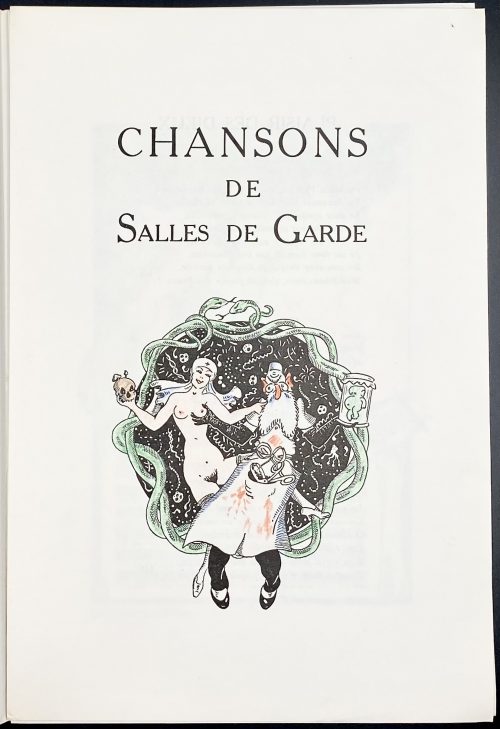 Title-page: CHANSONS | DE | SALLES DE GARDE | {vignette} || Description: 27.5 x 18.5 cm, in pictorial French flapped wrapper and in a green cloth folder, vertically lettered to spine “CHANSONS” in black letters, a flute benith. Pagination: [1-3] 4-140 [4] plus 52 plates extraneous to collation (Dutel provides for 142 pp.) Illustrations: plates, headbands, vignettes to front wrapper, title-page and limitation page, as well as the vignette at the end, reproduced after drawings by Morvan (according to J.-P. Dutel) and hand-coloured with crayons (the question remains, is it Hervé Morvan, French, 1917 – 1980?) Limitation: 950 copies of which 25 marked A to Z; 25 copies consist of an additional suite and one original drawing (№ 1-25); 25 copies have an original drawing (№ 26-50), and 875 copies numbered 51 to 950. This copy is № 697. Catalogue raisonné: Dutel (1920-1970): № 1186.
Title-page: CHANSONS | DE | SALLES DE GARDE | {vignette} || Description: 27.5 x 18.5 cm, in pictorial French flapped wrapper and in a green cloth folder, vertically lettered to spine “CHANSONS” in black letters, a flute benith. Pagination: [1-3] 4-140 [4] plus 52 plates extraneous to collation (Dutel provides for 142 pp.) Illustrations: plates, headbands, vignettes to front wrapper, title-page and limitation page, as well as the vignette at the end, reproduced after drawings by Morvan (according to J.-P. Dutel) and hand-coloured with crayons (the question remains, is it Hervé Morvan, French, 1917 – 1980?) Limitation: 950 copies of which 25 marked A to Z; 25 copies consist of an additional suite and one original drawing (№ 1-25); 25 copies have an original drawing (№ 26-50), and 875 copies numbered 51 to 950. This copy is № 697. Catalogue raisonné: Dutel (1920-1970): № 1186. -
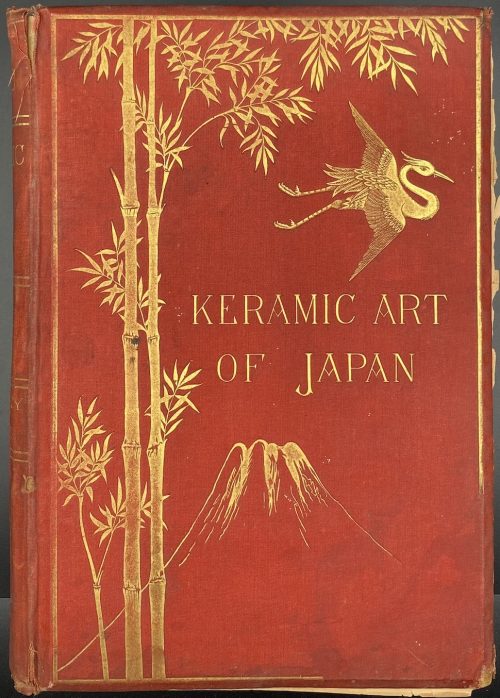 Title-page (in red and black): Keramic art of Japan, | BY | GEORGE A. AUDSLEY | AND | JAMES L. BOWES. | LONDON: HENRY SOTHERAN & CO., | 36 PICADILLY; 136, STRAND; 77 & 78, QUEEN STREET, CITY. | MANCHESTER: 49, CROSS STREET. | MDCCCLXXXI. || Description: 28.5 x 19.5 cm, publisher’s red cloth, bevelled boards, gilt lettering and tooling on front cover and spine, AEG, disbound. 304 p., 10 pl., 32 chromo-lithographed plates. This is the 2nd edition of the 1875 folio edition by the same publisher.. Contents: Introductory essay on Japanese art: p. 1-107; Keramic art of Japan: p. 108-260; Marks and monograms: p. 261-287, Index: p. 288-304. Contributors: George Ashdown Audsley (American, 1838 – 1925) – author. James Lord Bowes (British, 1834 – 1899) – author.
Title-page (in red and black): Keramic art of Japan, | BY | GEORGE A. AUDSLEY | AND | JAMES L. BOWES. | LONDON: HENRY SOTHERAN & CO., | 36 PICADILLY; 136, STRAND; 77 & 78, QUEEN STREET, CITY. | MANCHESTER: 49, CROSS STREET. | MDCCCLXXXI. || Description: 28.5 x 19.5 cm, publisher’s red cloth, bevelled boards, gilt lettering and tooling on front cover and spine, AEG, disbound. 304 p., 10 pl., 32 chromo-lithographed plates. This is the 2nd edition of the 1875 folio edition by the same publisher.. Contents: Introductory essay on Japanese art: p. 1-107; Keramic art of Japan: p. 108-260; Marks and monograms: p. 261-287, Index: p. 288-304. Contributors: George Ashdown Audsley (American, 1838 – 1925) – author. James Lord Bowes (British, 1834 – 1899) – author. -
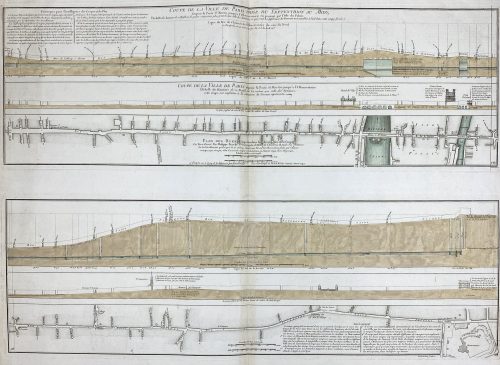
Two prints on one sheet of watermarked laid paper.
Coupe de la ville de Paris prise du septentrion au midy, depuis la porte St Martin jusqu'à l'Observatoire en passant par l'isle du Palais... Coupe de la ville de Paris depuis la porte St Martin jusqu'à l'Observatoire... Plan des rues comprises dans la direction dela coupe... / Le tout dressé par Philippe Buache... ; Desbruslins, sculpsit.
Watermark: "IHS" within circle; countermark of "FIN/ DUPUY/ AUVERGNE 1749".
LOC dates it to 1757. Gallica – to 1742, though the watermark is 1749.
-
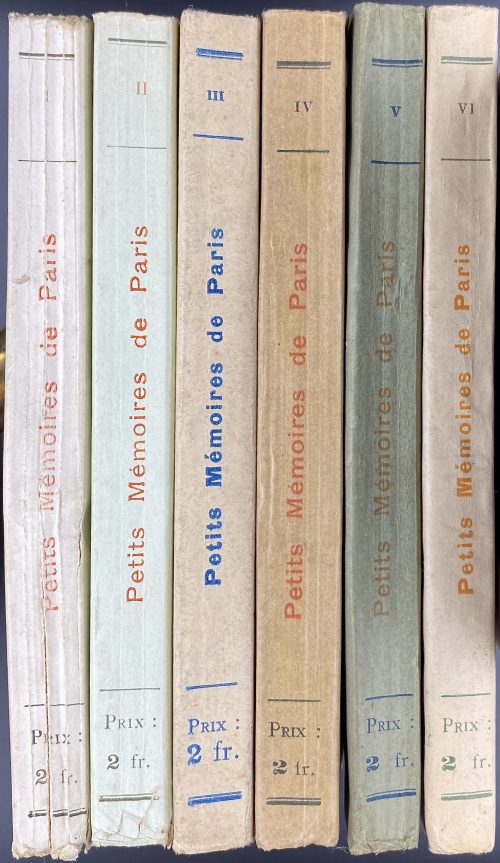 Description: Six softcover volumes, collated in-4to, 14.3 x 10 cm in publisher’s lettered wrappers; printed on laid paper; series "Les petits mémoires de Paris" illustrated with 23 out of 24 etchings by Henri Boutet: (I) Les coulisses de l’amour; (II) Rues et Intérieurs; (III) Le carnet d’un suiveur; (IV) Le petits métiers; (V) Les nuits de Paris; (VI) Toutes les bohêmes. Vol. I: Cream cover, lettered black and red in a black frame: LA MÉSSAGÈRE | LES | PETITS MÉMOIRES | DE | PARIS | CONTENANT | Quatre Eaux-Fortes originales | PAR | Henri BOUTET | I | Les Coulisses de l’Amour | {vignette brown Notre-Dame de Paris} | A PARIS | CHEZ DORBON l’AINÉ, LIBRAIRE | 53 ter, Quai des Grands-Augustins || Title-page: similar, in black, with «MDCCCVIII» in the bottom. Edition not stated. [1-8] ( 7 marked 1) 9-125 [3] contents, colophon; h.t. uncut from 1st blank, three original etchings instead of four (one missing?), incl. frontispiece. Colophon: IMPRIMÉ PAR SOINS | DE LA | SOCIÉTÉ TYPOGRAPHIQUE | DE | CHATEAUDUN || Back wrapper blank. Vol. II: Mint-green cover, lettered black and red in a black frame: LA MÉSSAGÈRE | LES | PETITS MÉMOIRES | DE | PARIS | CONTENANT | Quatre Eaux-Fortes originales | PAR | Henri BOUTET | II | Rues et Intérieurs | {vignette brown Notre-Dame de Paris} | A PARIS | CHEZ DORBON l’AINÉ, LIBRAIRE | 53 ter, Quai des Grands-Augustins || Title-page: similar, in black, with «MDCCCIX» in the bottom. Edition not stated. [1-6] 7-125 [2] contents, colophon (same as in Vol. I); h.t. uncut from 1st blank, four original etchings, incl. frontispiece. Back wrapper blank. Vol. III: Cream cover, lettered blue in a blue frame: LA MÉSSAGÈRE | LES | PETITS MÉMOIRES | DE | PARIS | CONTENANT | Quatre Eaux-Fortes originales | PAR | Henri BOUTET | III | Le Carnet d’un Suiveur | 4e Edition | {vignette smoking gentleman in a top hat} | A PARIS | CHEZ DORBON L’AINÉ, LIBRAIRE | 53 ter, Quai des Grands-Augustins || Title-page: similar, in black, with «MDCCCIX» in the bottom. 4th edition. [1-6] 7-124 [4] contents, colophon (uncut); h.t. uncut from 1st blank, four original etchings, incl. frontispiece. Colophon: Imprimé par soins de | l’Imprimerie de Paris | Têtes de chapitre, lettrines et culs de lampe de | M. Paul Guignebault | Eaux-fortes tirées sous la direction de | M. Henri Boutet || Back wrapper with a frame and a ribbon at center, in blue. Vol. IV: Tan cover, lettered red and black in a black frame: LA MÉSSAGÈRE | LES | PETITS MÉMOIRES | DE | PARIS | CONTENANT | Quatre Eaux-Fortes originales | PAR | Henri BOUTET | IV | Le Petits Métiers | {vignette worker with a ladder} | A PARIS | CHEZ DORBON L’AINÉ, LIBRAIRE | 53 ter, Quai des Grands-Augustins || Title-page: similar, in black, with «MDCCCIX» in the bottom. Edition not stated. [1-6] 7-119 [120 colophon, uncut] [8 advert., uncut]; four original etchings, incl. frontispiece. Colophon: IMPRIMERIE DE PARIS | 22, RUE DES VOLONTAIRES PROLONGÉE | – PARIS - XVe – || Back wrapper with a black frame and a red ribbon at center. Vol. V: Olive-green cover, lettered red and blue in a blue frame: LA MÉSSAGÈRE | LES | PETITS MÉMOIRES | DE | PARIS | CONTENANT | Quatre Eaux-Fortes originales | PAR | Henri BOUTET | V | Les nuits de Paris | Deuxième Édition | {vignette woman on a street} | A PARIS | CHEZ DORBON L’AINÉ, LIBRAIRE | 53 ter, Quai des Grands-Augustins || Title-page: similar, in black, with «MDCDIX» in the bottom. 2nd edition. [1-8] 9-118 [2 colophon, uncut] [8 advert., uncut]; four original etchings, incl. frontispiece. Colophon: IMPRIMERIE DE PARIS | 22, RUE DES VOLONTAIRES PROLONGÉE | – PARIS - XVe – || Back wrapper with a blue frame and a red ribbon at center. Vol. VI: Cream cover, lettered red and blue in a blue frame: LA MÉSSAGÈRE | LES | PETITS MÉMOIRES | DE | PARIS | CONTENANT | Quatre Eaux-Fortes originales | PAR | Henri BOUTET | VI | Toutes les bohêmes | Cinquième Édition | {vignette windmill} | A PARIS | CHEZ DORBON L’AINÉ, LIBRAIRE | 53 ter, Quai des Grands-Augustins || Title-page: similar, in black, with «MDCDIX» in the bottom and “Deuxième Édition”. 5th or 2nd edition. [1-7] 8-120 [2 colophon] [4 advert.] [2 blank]; four original etchings, incl. frontispiece. Colophon: IMPRIMERIE DE PARIS | 22, RUE DES VOLONTAIRES PROLONGÉE | – PARIS - XVe – || Back wrapper with a blue frame and a red ribbon at center. Contributors: Henri Boutet [La Mésangère] (French, 1851 – 1919) – author, artist, etcher. François Louis Dorbon [Dorbon Aîné] (French, 1878 – 1956) – publisher.
Description: Six softcover volumes, collated in-4to, 14.3 x 10 cm in publisher’s lettered wrappers; printed on laid paper; series "Les petits mémoires de Paris" illustrated with 23 out of 24 etchings by Henri Boutet: (I) Les coulisses de l’amour; (II) Rues et Intérieurs; (III) Le carnet d’un suiveur; (IV) Le petits métiers; (V) Les nuits de Paris; (VI) Toutes les bohêmes. Vol. I: Cream cover, lettered black and red in a black frame: LA MÉSSAGÈRE | LES | PETITS MÉMOIRES | DE | PARIS | CONTENANT | Quatre Eaux-Fortes originales | PAR | Henri BOUTET | I | Les Coulisses de l’Amour | {vignette brown Notre-Dame de Paris} | A PARIS | CHEZ DORBON l’AINÉ, LIBRAIRE | 53 ter, Quai des Grands-Augustins || Title-page: similar, in black, with «MDCCCVIII» in the bottom. Edition not stated. [1-8] ( 7 marked 1) 9-125 [3] contents, colophon; h.t. uncut from 1st blank, three original etchings instead of four (one missing?), incl. frontispiece. Colophon: IMPRIMÉ PAR SOINS | DE LA | SOCIÉTÉ TYPOGRAPHIQUE | DE | CHATEAUDUN || Back wrapper blank. Vol. II: Mint-green cover, lettered black and red in a black frame: LA MÉSSAGÈRE | LES | PETITS MÉMOIRES | DE | PARIS | CONTENANT | Quatre Eaux-Fortes originales | PAR | Henri BOUTET | II | Rues et Intérieurs | {vignette brown Notre-Dame de Paris} | A PARIS | CHEZ DORBON l’AINÉ, LIBRAIRE | 53 ter, Quai des Grands-Augustins || Title-page: similar, in black, with «MDCCCIX» in the bottom. Edition not stated. [1-6] 7-125 [2] contents, colophon (same as in Vol. I); h.t. uncut from 1st blank, four original etchings, incl. frontispiece. Back wrapper blank. Vol. III: Cream cover, lettered blue in a blue frame: LA MÉSSAGÈRE | LES | PETITS MÉMOIRES | DE | PARIS | CONTENANT | Quatre Eaux-Fortes originales | PAR | Henri BOUTET | III | Le Carnet d’un Suiveur | 4e Edition | {vignette smoking gentleman in a top hat} | A PARIS | CHEZ DORBON L’AINÉ, LIBRAIRE | 53 ter, Quai des Grands-Augustins || Title-page: similar, in black, with «MDCCCIX» in the bottom. 4th edition. [1-6] 7-124 [4] contents, colophon (uncut); h.t. uncut from 1st blank, four original etchings, incl. frontispiece. Colophon: Imprimé par soins de | l’Imprimerie de Paris | Têtes de chapitre, lettrines et culs de lampe de | M. Paul Guignebault | Eaux-fortes tirées sous la direction de | M. Henri Boutet || Back wrapper with a frame and a ribbon at center, in blue. Vol. IV: Tan cover, lettered red and black in a black frame: LA MÉSSAGÈRE | LES | PETITS MÉMOIRES | DE | PARIS | CONTENANT | Quatre Eaux-Fortes originales | PAR | Henri BOUTET | IV | Le Petits Métiers | {vignette worker with a ladder} | A PARIS | CHEZ DORBON L’AINÉ, LIBRAIRE | 53 ter, Quai des Grands-Augustins || Title-page: similar, in black, with «MDCCCIX» in the bottom. Edition not stated. [1-6] 7-119 [120 colophon, uncut] [8 advert., uncut]; four original etchings, incl. frontispiece. Colophon: IMPRIMERIE DE PARIS | 22, RUE DES VOLONTAIRES PROLONGÉE | – PARIS - XVe – || Back wrapper with a black frame and a red ribbon at center. Vol. V: Olive-green cover, lettered red and blue in a blue frame: LA MÉSSAGÈRE | LES | PETITS MÉMOIRES | DE | PARIS | CONTENANT | Quatre Eaux-Fortes originales | PAR | Henri BOUTET | V | Les nuits de Paris | Deuxième Édition | {vignette woman on a street} | A PARIS | CHEZ DORBON L’AINÉ, LIBRAIRE | 53 ter, Quai des Grands-Augustins || Title-page: similar, in black, with «MDCDIX» in the bottom. 2nd edition. [1-8] 9-118 [2 colophon, uncut] [8 advert., uncut]; four original etchings, incl. frontispiece. Colophon: IMPRIMERIE DE PARIS | 22, RUE DES VOLONTAIRES PROLONGÉE | – PARIS - XVe – || Back wrapper with a blue frame and a red ribbon at center. Vol. VI: Cream cover, lettered red and blue in a blue frame: LA MÉSSAGÈRE | LES | PETITS MÉMOIRES | DE | PARIS | CONTENANT | Quatre Eaux-Fortes originales | PAR | Henri BOUTET | VI | Toutes les bohêmes | Cinquième Édition | {vignette windmill} | A PARIS | CHEZ DORBON L’AINÉ, LIBRAIRE | 53 ter, Quai des Grands-Augustins || Title-page: similar, in black, with «MDCDIX» in the bottom and “Deuxième Édition”. 5th or 2nd edition. [1-7] 8-120 [2 colophon] [4 advert.] [2 blank]; four original etchings, incl. frontispiece. Colophon: IMPRIMERIE DE PARIS | 22, RUE DES VOLONTAIRES PROLONGÉE | – PARIS - XVe – || Back wrapper with a blue frame and a red ribbon at center. Contributors: Henri Boutet [La Mésangère] (French, 1851 – 1919) – author, artist, etcher. François Louis Dorbon [Dorbon Aîné] (French, 1878 – 1956) – publisher. -
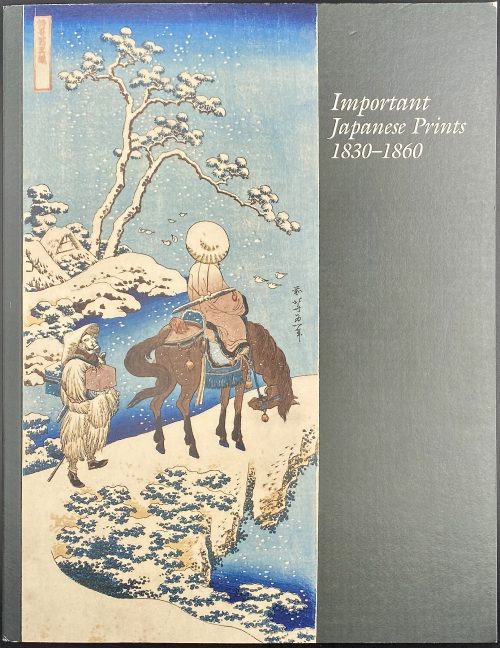 Softcover, in pictorial wrappers, 28 x 22 cm, 67 items, with colour illustrations, some folding. Catalogue of the sales exhibition on March 14-20, 2020 in NY; pagination: [1-3] 4-120 [8], ils. 6 fan prints. Contributor: Sebastian Izzard
Softcover, in pictorial wrappers, 28 x 22 cm, 67 items, with colour illustrations, some folding. Catalogue of the sales exhibition on March 14-20, 2020 in NY; pagination: [1-3] 4-120 [8], ils. 6 fan prints. Contributor: Sebastian Izzard -
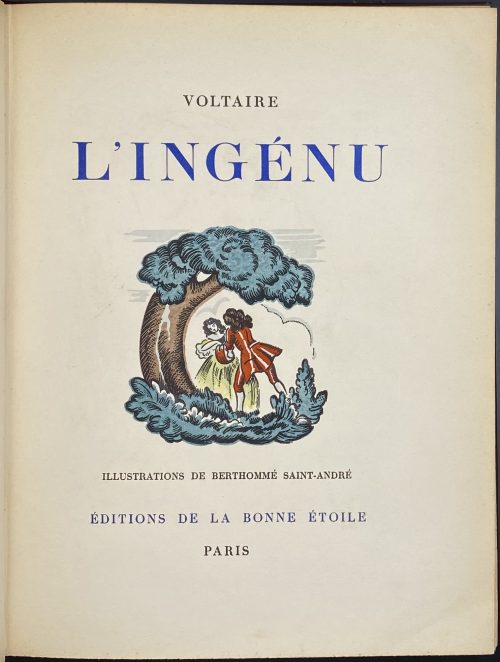 Description: One volume, 27 x 21.5 cm, collated 4to, bound in full dark crimson calf with gilt floral border, raised bands with gilt filets, gilt lettering to spine, 16 colour plates, one of them loose, and numerous woodcut tailpieces. Title-page: (black and blue): VOLTAIRE | L'INGÉNU | {VIGNETTE} | ILLUSTRATIONS DE BERTHOMMÉ SAINT-ANDRÉ | ÉDITIONS DE LA BONNE ÉTOILE | PARIS || Collation: 4to; π4 (2 blanks, h.t./limitation, t.p.), 1-184, last blank; total 76 leaves plus 16 colour plates after Louis Berthommé Saint-André and two flyleaves, first and last. Pagination: [4 blanks] [1-4] 5-143 [144] [4 blanks]; total 152 pages, ils. Limitation: Edition limited to 2,500 copies, of which this is copy № 1621. Colophon: Printed under direction of Paul Cotinaud at L’Union Typographique by Henri Leduc; photogravures executed by G. Duval and coloured by E. Vairel fils. Contributors: François Marie Arouet de Voltaire (French, 1694 – 1778) – author. Louis Berthomme Saint-André (French, 1905 – 1977) – artist.
Description: One volume, 27 x 21.5 cm, collated 4to, bound in full dark crimson calf with gilt floral border, raised bands with gilt filets, gilt lettering to spine, 16 colour plates, one of them loose, and numerous woodcut tailpieces. Title-page: (black and blue): VOLTAIRE | L'INGÉNU | {VIGNETTE} | ILLUSTRATIONS DE BERTHOMMÉ SAINT-ANDRÉ | ÉDITIONS DE LA BONNE ÉTOILE | PARIS || Collation: 4to; π4 (2 blanks, h.t./limitation, t.p.), 1-184, last blank; total 76 leaves plus 16 colour plates after Louis Berthommé Saint-André and two flyleaves, first and last. Pagination: [4 blanks] [1-4] 5-143 [144] [4 blanks]; total 152 pages, ils. Limitation: Edition limited to 2,500 copies, of which this is copy № 1621. Colophon: Printed under direction of Paul Cotinaud at L’Union Typographique by Henri Leduc; photogravures executed by G. Duval and coloured by E. Vairel fils. Contributors: François Marie Arouet de Voltaire (French, 1694 – 1778) – author. Louis Berthomme Saint-André (French, 1905 – 1977) – artist. -
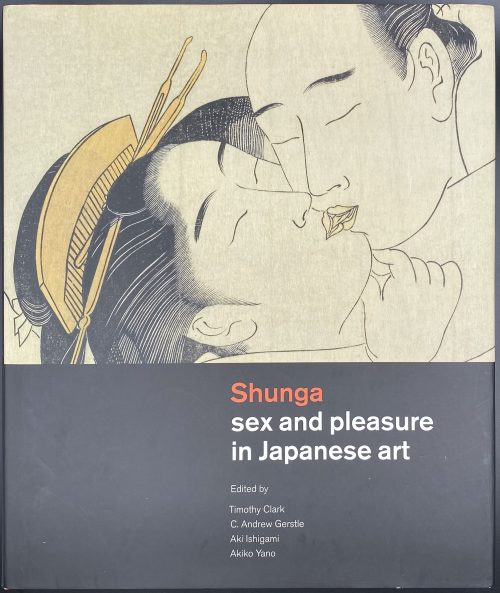 Hardcover volume, 29.6 x 25 x 4 cm, in red cloth with black lettering to spine, in pictorial dust jacket, profusely illustrated in colour; pp.: [1-6] 7-536, total 268 leaves and 2 folding plates extraneous to collation. Title-page: {Hotei's device} Hotei Publishing | Shunga | sex and pleasure in Japanese art | Edited by | Timothy Clark | C. Andrew Gerstle | Aki Ishigami | Akiki Yano || Contents: The Cultural Historical Significance and Importance of Japanese Shunga / Kobayashi Tadashi. Introduction: What Was Shunga? / C. Andrew Gerstle; Who Were the Audiences for Shunga? / Hayakawa Monta. (1) Early Shunga before 1765: Shunga Paintings before the `Floating World' / Akiko Yano; Chinese Chunhua and Japanese Shunga / Ishigami Aki; Shunga and the Rise of Print Culture / Asano Shugo. (2) Masterpieces of Shunga 1765-1850: The Essence of Ukiyo-e Shunga / Kobayashi Tadashi; Erotic Books as Luxury Goods / Ellis Tinios; Listening to the Voices in Shunga / Hayakawa Monta; The Tale of Genji in Shunga / Sato Satoru. (3) Censorship: Timeline of Censorship; Shunga and Censorship in the Edo Period (1600-1868) / Jennifer Preston; Graph of approximate output of shunga print series and books; The Censorship of Shunga in the Modern Era / Ishigami Aki; Shunga Studies in the Showa Era (1926-89) / Shirakura Yoshihiko. (4) Contexts for Shunga: Traditional Uses of Shunga / Yamamoto Yukari; The Distribution and Circulation of Erotic Prints and Books in the Edo Period Laura Moretti; Shunga and Parody / C. Andrew Gerstle; Popular Cults of Sex Organs in Japan / Suzuki Kenko; Grotesque Shunga / Ishigami Aki; Violence in Shunga / Higuchi Kazutaka; Foreign Connections in Shunga / Timon Screech; Children in Shunga / Akiko Yano; Shunga and the Floating World / Matsuba Ryoko. (5) Shunga in the Meiji Era: Erotic Art of the Meiji Era (1868-1912) / Rosina Buckland; The Modern West's Discovery of Shunga / Ricard Bru. Published to accompany the exhibition Shunga: sex and pleasure in Japanese art at the British Museum from 3 October 2013 to 5 January 2014. Abstract: This catalogue aims to answer some key questions about what is shunga and why it was produced. In particular, the social and cultural contexts for sex art in Japan are explored. Erotic Japanese art was heavily suppressed in Japan from the 1870s onwards as part of a process of cultural 'modernisation' that imported many contemporary western moral values. Only in the last twenty years or so has it been possible to publish unexpurgated examples in Japan and this landmark book places erotic Japanese art in its historical and cultural context for the first time. This book looks at painted and printed erotic images produced in Japan during the Edo period (1600-1868) and early Meiji era (1868-1912). These are related to the wider contexts of literature, theatre, the culture of the pleasure quarters, and urban consumerism; and interpreted in terms of their sensuality, reverence, humour and parody. Contributors: Timothy Clark (British, b. 1959) Timothy Clark (British, b. 1959) C. Andrew Gerstle (American, 1951) Aki Ishigami [石上阿希] (Japanese) Akiki Yano
Hardcover volume, 29.6 x 25 x 4 cm, in red cloth with black lettering to spine, in pictorial dust jacket, profusely illustrated in colour; pp.: [1-6] 7-536, total 268 leaves and 2 folding plates extraneous to collation. Title-page: {Hotei's device} Hotei Publishing | Shunga | sex and pleasure in Japanese art | Edited by | Timothy Clark | C. Andrew Gerstle | Aki Ishigami | Akiki Yano || Contents: The Cultural Historical Significance and Importance of Japanese Shunga / Kobayashi Tadashi. Introduction: What Was Shunga? / C. Andrew Gerstle; Who Were the Audiences for Shunga? / Hayakawa Monta. (1) Early Shunga before 1765: Shunga Paintings before the `Floating World' / Akiko Yano; Chinese Chunhua and Japanese Shunga / Ishigami Aki; Shunga and the Rise of Print Culture / Asano Shugo. (2) Masterpieces of Shunga 1765-1850: The Essence of Ukiyo-e Shunga / Kobayashi Tadashi; Erotic Books as Luxury Goods / Ellis Tinios; Listening to the Voices in Shunga / Hayakawa Monta; The Tale of Genji in Shunga / Sato Satoru. (3) Censorship: Timeline of Censorship; Shunga and Censorship in the Edo Period (1600-1868) / Jennifer Preston; Graph of approximate output of shunga print series and books; The Censorship of Shunga in the Modern Era / Ishigami Aki; Shunga Studies in the Showa Era (1926-89) / Shirakura Yoshihiko. (4) Contexts for Shunga: Traditional Uses of Shunga / Yamamoto Yukari; The Distribution and Circulation of Erotic Prints and Books in the Edo Period Laura Moretti; Shunga and Parody / C. Andrew Gerstle; Popular Cults of Sex Organs in Japan / Suzuki Kenko; Grotesque Shunga / Ishigami Aki; Violence in Shunga / Higuchi Kazutaka; Foreign Connections in Shunga / Timon Screech; Children in Shunga / Akiko Yano; Shunga and the Floating World / Matsuba Ryoko. (5) Shunga in the Meiji Era: Erotic Art of the Meiji Era (1868-1912) / Rosina Buckland; The Modern West's Discovery of Shunga / Ricard Bru. Published to accompany the exhibition Shunga: sex and pleasure in Japanese art at the British Museum from 3 October 2013 to 5 January 2014. Abstract: This catalogue aims to answer some key questions about what is shunga and why it was produced. In particular, the social and cultural contexts for sex art in Japan are explored. Erotic Japanese art was heavily suppressed in Japan from the 1870s onwards as part of a process of cultural 'modernisation' that imported many contemporary western moral values. Only in the last twenty years or so has it been possible to publish unexpurgated examples in Japan and this landmark book places erotic Japanese art in its historical and cultural context for the first time. This book looks at painted and printed erotic images produced in Japan during the Edo period (1600-1868) and early Meiji era (1868-1912). These are related to the wider contexts of literature, theatre, the culture of the pleasure quarters, and urban consumerism; and interpreted in terms of their sensuality, reverence, humour and parody. Contributors: Timothy Clark (British, b. 1959) Timothy Clark (British, b. 1959) C. Andrew Gerstle (American, 1951) Aki Ishigami [石上阿希] (Japanese) Akiki Yano -
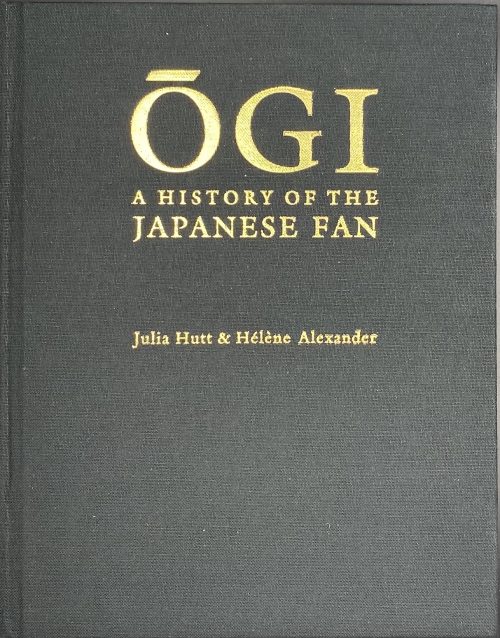 Hardcover, 29.7 x 23.7 cm, black cloth with gilt lettering to front cover and spine, pictorial dust jacket, gilt slipcase; pp.: [1-4] 5-112, ils.; 97 catalogue entries. Exhibition “Fans of the four seasons” and The Fan Museum, Greenwich. Contributors: Julia Hutt Hélène Alexander
Hardcover, 29.7 x 23.7 cm, black cloth with gilt lettering to front cover and spine, pictorial dust jacket, gilt slipcase; pp.: [1-4] 5-112, ils.; 97 catalogue entries. Exhibition “Fans of the four seasons” and The Fan Museum, Greenwich. Contributors: Julia Hutt Hélène Alexander -
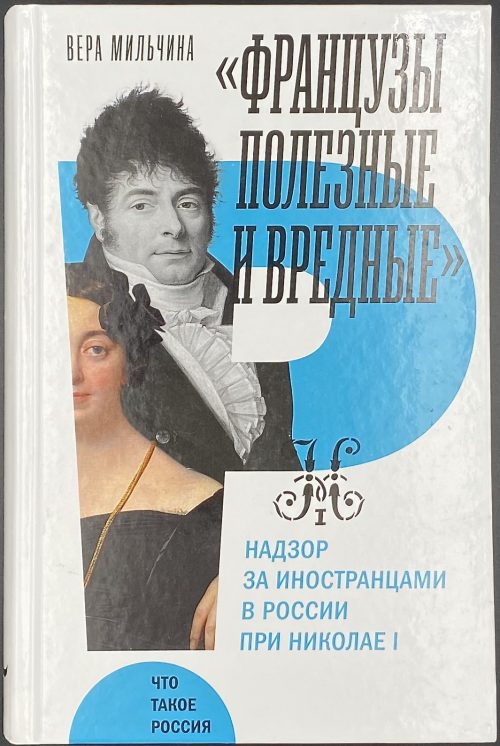 Description: One volume, 20.6 x 13.7 cm, pictorial glossy paper boards; pp.: [1-6] 7-480 [481] [7 advert.]; total 488 pages, ils. ISBN: 978-5-4448-0627-2. Contributor: Вера Аркадьевна Мильчина [Vera Miltchina] (Russian, b. 1953)
Description: One volume, 20.6 x 13.7 cm, pictorial glossy paper boards; pp.: [1-6] 7-480 [481] [7 advert.]; total 488 pages, ils. ISBN: 978-5-4448-0627-2. Contributor: Вера Аркадьевна Мильчина [Vera Miltchina] (Russian, b. 1953) -
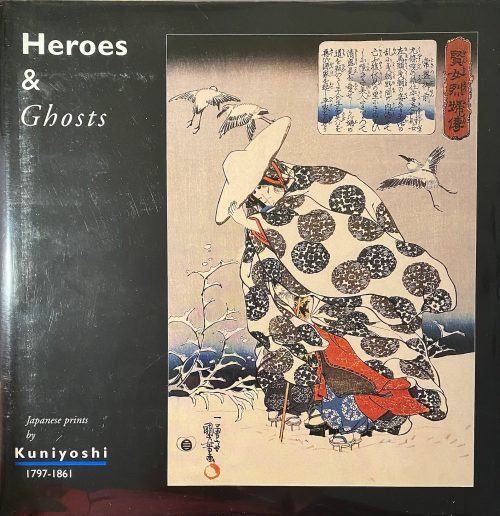 Title-page: Heroes & Ghosts | Japanese prints | by | Kuniyoshi | 1797-1861 | [space] | Robert Schaap | introduction by | Amy Reigle Newland | essays by | Timothy T. Clark | Matthi Forrer | Inagaki Shin'ichi | {publisher’s device} | Hotei Publishing, Leiden | Society for Japanese Arts || Description: Square hardcover volume, 29.3 x 29 cm, bound in black cloth with blind vignette to front cover and blind lettering to spine, black pictorial endpapers, pictorial dust jacket; pp.: [1-4] 5-280, incl. 279 plates and 31 figures in the text; based on exhibit in Van Gogh Museum (Amsterdam) 30 Jan – 5 Apr 1998 and Philadelphia Museum of Art (Philadelphia) 24 Apr – 29 Jun 1998.
Title-page: Heroes & Ghosts | Japanese prints | by | Kuniyoshi | 1797-1861 | [space] | Robert Schaap | introduction by | Amy Reigle Newland | essays by | Timothy T. Clark | Matthi Forrer | Inagaki Shin'ichi | {publisher’s device} | Hotei Publishing, Leiden | Society for Japanese Arts || Description: Square hardcover volume, 29.3 x 29 cm, bound in black cloth with blind vignette to front cover and blind lettering to spine, black pictorial endpapers, pictorial dust jacket; pp.: [1-4] 5-280, incl. 279 plates and 31 figures in the text; based on exhibit in Van Gogh Museum (Amsterdam) 30 Jan – 5 Apr 1998 and Philadelphia Museum of Art (Philadelphia) 24 Apr – 29 Jun 1998. -
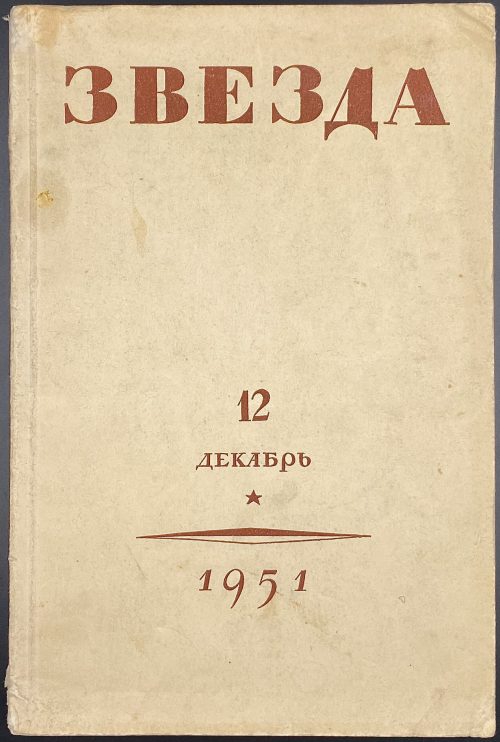 Sergei Petrovich Varshavsky [Сергей Петрович Варшавский] (Jewish-Russian, 1906 – 1980). B. Rest [Б. Рест; Юлий Исаакович Шапиро] (Jewish-Russian, fl. 1940 – 1980). Monthly magazine Star ("Звезда", Zvezda) published from 1924; circulation of 60,000 copies. Editor-in-Chief: Валерий Павлович Друзин (Russian, 1903 – 1980). Softcover, original wrappers, 25.3 x 16.8 cm, pp.: [2] 3-190 [2], total 192 pages; collated 8vo: [1]-128, total 96 leaves.
Sergei Petrovich Varshavsky [Сергей Петрович Варшавский] (Jewish-Russian, 1906 – 1980). B. Rest [Б. Рест; Юлий Исаакович Шапиро] (Jewish-Russian, fl. 1940 – 1980). Monthly magazine Star ("Звезда", Zvezda) published from 1924; circulation of 60,000 copies. Editor-in-Chief: Валерий Павлович Друзин (Russian, 1903 – 1980). Softcover, original wrappers, 25.3 x 16.8 cm, pp.: [2] 3-190 [2], total 192 pages; collated 8vo: [1]-128, total 96 leaves. -
 Russian translation of Louis-Sébastien Mercier. Tableau de Paris (1781). First edition, thus. Two volumes, 19.5 x 14 cm, uniformly bound in blue cloth with dark blue vignette to front cover and lettering to spine, in pictorial dust jacket; pp. vol. I: [I-VI] VII-LIII [LIV] [2] [2] 3-565 [566] [2]; collated 8vo: [I]-III8, IV4, [1]-358 364; total 312 leaves (624 pages) plus repro engraved frontispiece and 21 plates; vol 2: [1-10] 11-492 [4], collated 8vo: [1]-318; total 248 leaves (496 pages) plus 29 plates. Design by Н. В. Кузьмин. Title-page (black and red): ЛУИ-СЕБАСТЬЯН МЕРСЬЕ | КАРТИНЫ ПАРИЖА | Перевод В. А. Барбашевой | Редакция и комментарии | Е. А. Гунста | Статья Ц. Фридлянда | ТОМ ПЕРВЫЙ (ВТОРОЙ) | ACADEMIA | 1935(6) || Opposite t.p. (black and red): ФРАНЦУЗСКАЯ ЛИТЕРАТУРА | ЛУИ-СЕБАСТЬЯН МЕРСЬЕ | 1740—1814 | ACADEMIA | Москва—Ленинград || T.p. verso: LOUIS-SÉBASTIEN MERCIER | TABLEAU DE PARIS | 1781 | Супер-обложка и переплет | Н. В. Кузьмина || Print run: 5,300 copies. Catalogue raisonné: Крылов-Кичатова 747 (vol. 1), 838 (vol. 2). Contributors: Louis-Sébastien Mercier (French, 1740 – 1814) – author. Барбашева, Вера Александровна (Russian, 1875 – 1943) – translator. Гунст, Евгений Анатольевич (Russian, 1901 – 1983) – editor, comments. Фридлянд, Цви [Григорий Самойлович] (Russian-Jewish, 1897 – 1937) – author (preface). Kuzmin, Nikolai Vasilievich [Кузьмин, Николай Васильевич] (Russian, 1890 – 1987) – artist.
Russian translation of Louis-Sébastien Mercier. Tableau de Paris (1781). First edition, thus. Two volumes, 19.5 x 14 cm, uniformly bound in blue cloth with dark blue vignette to front cover and lettering to spine, in pictorial dust jacket; pp. vol. I: [I-VI] VII-LIII [LIV] [2] [2] 3-565 [566] [2]; collated 8vo: [I]-III8, IV4, [1]-358 364; total 312 leaves (624 pages) plus repro engraved frontispiece and 21 plates; vol 2: [1-10] 11-492 [4], collated 8vo: [1]-318; total 248 leaves (496 pages) plus 29 plates. Design by Н. В. Кузьмин. Title-page (black and red): ЛУИ-СЕБАСТЬЯН МЕРСЬЕ | КАРТИНЫ ПАРИЖА | Перевод В. А. Барбашевой | Редакция и комментарии | Е. А. Гунста | Статья Ц. Фридлянда | ТОМ ПЕРВЫЙ (ВТОРОЙ) | ACADEMIA | 1935(6) || Opposite t.p. (black and red): ФРАНЦУЗСКАЯ ЛИТЕРАТУРА | ЛУИ-СЕБАСТЬЯН МЕРСЬЕ | 1740—1814 | ACADEMIA | Москва—Ленинград || T.p. verso: LOUIS-SÉBASTIEN MERCIER | TABLEAU DE PARIS | 1781 | Супер-обложка и переплет | Н. В. Кузьмина || Print run: 5,300 copies. Catalogue raisonné: Крылов-Кичатова 747 (vol. 1), 838 (vol. 2). Contributors: Louis-Sébastien Mercier (French, 1740 – 1814) – author. Барбашева, Вера Александровна (Russian, 1875 – 1943) – translator. Гунст, Евгений Анатольевич (Russian, 1901 – 1983) – editor, comments. Фридлянд, Цви [Григорий Самойлович] (Russian-Jewish, 1897 – 1937) – author (preface). Kuzmin, Nikolai Vasilievich [Кузьмин, Николай Васильевич] (Russian, 1890 – 1987) – artist. -
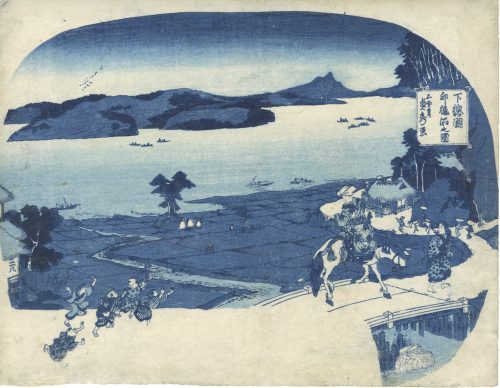 An uncut aizuri fan print showing travellers arriving at Inba Lake [印旛沼] (Inba-numa) on Shimosa Plateau [下総台地] (Shimōsa-daichi). Artist: Utagawa Sadahide [歌川貞秀] (Japanese, 1807 – 1879) Publisher: Unknown. Published: c. 1849. Signed: Gountei Sadahide ga [五雲亭 貞秀画] (Picture by Gountei Sadahide). Inscription in cartouche: Shimosa Plateau, Inbanuma (Inba Lake) [下總國印幡沼]. No date seal, no censor seal (privately printed?) Media: Fan print [団扇絵] (uchiwa-e), 235 x 300 mm.
An uncut aizuri fan print showing travellers arriving at Inba Lake [印旛沼] (Inba-numa) on Shimosa Plateau [下総台地] (Shimōsa-daichi). Artist: Utagawa Sadahide [歌川貞秀] (Japanese, 1807 – 1879) Publisher: Unknown. Published: c. 1849. Signed: Gountei Sadahide ga [五雲亭 貞秀画] (Picture by Gountei Sadahide). Inscription in cartouche: Shimosa Plateau, Inbanuma (Inba Lake) [下總國印幡沼]. No date seal, no censor seal (privately printed?) Media: Fan print [団扇絵] (uchiwa-e), 235 x 300 mm. -
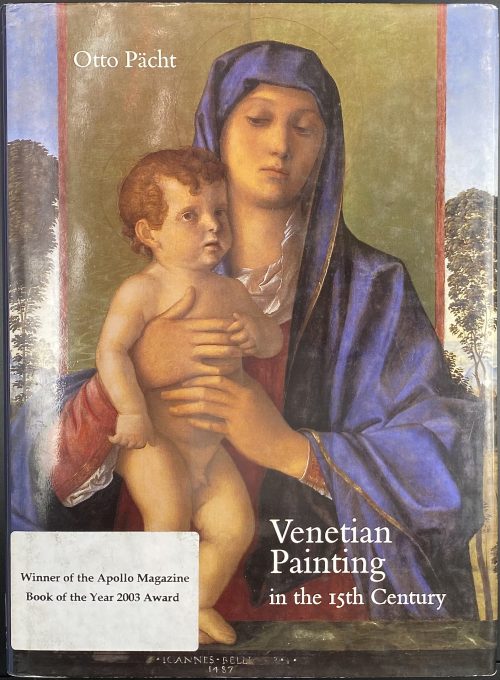 Hardcover, 28.5 x 21 cm, blue cloth, gilt lettering to spine, pictorial dust jacket with the glued white label “Winner of the Apollo Magazine | Book of the Year 2003 Award”; pp.: [1-9] 10-260, ils.; ISBN 9781872501543, 9781872501239, 1872501540, 1872501230. Title-page: OTTO PÄCHT | Venetian Painting | in the 15th Century | Jacopo, Gentile and Giovanni Bellini | and Andrea Mantegna | Edited by | Margareta Vyoral-Tschapka | and | Michael Pächt | {publisher’s device} | HARVEY MILLER PUBLISHERS || Contributors: Otto Pächt (Austrian, 1902 – 1988) Margareta Vyoral-Tschapka Michael Pächt (Austrian, b. 1942)
Hardcover, 28.5 x 21 cm, blue cloth, gilt lettering to spine, pictorial dust jacket with the glued white label “Winner of the Apollo Magazine | Book of the Year 2003 Award”; pp.: [1-9] 10-260, ils.; ISBN 9781872501543, 9781872501239, 1872501540, 1872501230. Title-page: OTTO PÄCHT | Venetian Painting | in the 15th Century | Jacopo, Gentile and Giovanni Bellini | and Andrea Mantegna | Edited by | Margareta Vyoral-Tschapka | and | Michael Pächt | {publisher’s device} | HARVEY MILLER PUBLISHERS || Contributors: Otto Pächt (Austrian, 1902 – 1988) Margareta Vyoral-Tschapka Michael Pächt (Austrian, b. 1942) -
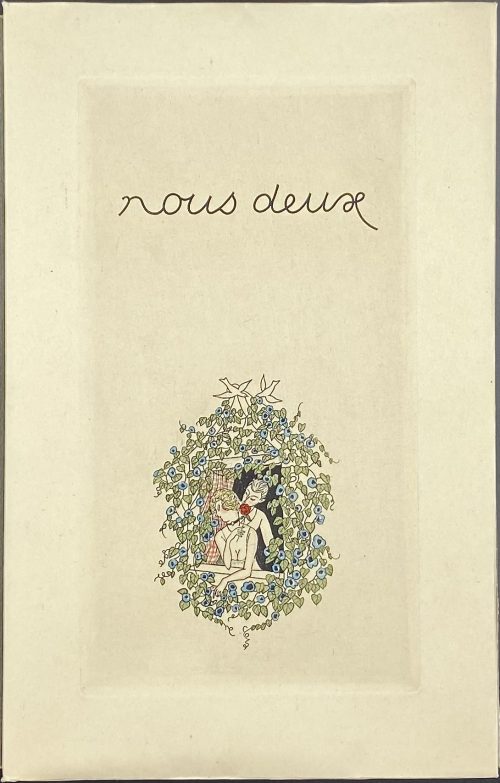 Description: Two volumes 23.1 x 14.9 cm each, collated in 4to, uniformly bound in French flapped wrappers with the title and an engraved vignette, coloured; wrapped in glassine; cased in a cardboard chemise (23.1 x 15 cm) with a diaper of two hearts pierced by an arrow, in pink; and both volumes cased in a slipcase (23.8 x 15.2 cm) with the same diaper. Printed on unpaginated dense wove paper watermarked ‘Arches’, engravings with clear plate marks. Illustrations are by Jean Dulac. Title-page (double-fillet frame, black and red in manuscript) Nelly et Jean | – | nous deux | simples | papiers | du| tiroir secret | {vignette} | Première partie (Deuxième partie) | – | Gravé | et imprimé | pour les auteurs | et leurs amis || Vol. 1: 1 blank, π4 (blank, h.t., frontis., engr. t.p.), 1-84, [2 blanks]; total 39 leaves with 19 hand-coloured burin engravings, incl. wrapper, frontis., and t.p. Unpag. Vol. 2: 1 blank, π4 (blank, h.t., frontis., engr. t.p.), 1-114, [1 colophon] [2 blanks], total 52 leaves with 27 hand-coloured burin engravings, incl. wrapper, frontis., and t.p. Unpag. Limitation: total print run of 295 copies of which 12 (№№ 1-12) on Japon Impérial, 13 on Vélin d’Arches (№№ 13-25), 30 on Japon Impérial (№№ 26-55) and 240 on Vélin d’Arches (№№ 56-295); this is copy № 97 on Vélin d’Arches. Contributors: Marcel Valotaire (French, 1889 – 1979) – author. Jean Dulac (French, 1902 – 1968) – artist. Printed by Coulouma (Argenteuil) and Vernant (Paris). The same title with illustrations by Gaston de Sainte-Croix was published in 1956: LIB-2880.2021.
Description: Two volumes 23.1 x 14.9 cm each, collated in 4to, uniformly bound in French flapped wrappers with the title and an engraved vignette, coloured; wrapped in glassine; cased in a cardboard chemise (23.1 x 15 cm) with a diaper of two hearts pierced by an arrow, in pink; and both volumes cased in a slipcase (23.8 x 15.2 cm) with the same diaper. Printed on unpaginated dense wove paper watermarked ‘Arches’, engravings with clear plate marks. Illustrations are by Jean Dulac. Title-page (double-fillet frame, black and red in manuscript) Nelly et Jean | – | nous deux | simples | papiers | du| tiroir secret | {vignette} | Première partie (Deuxième partie) | – | Gravé | et imprimé | pour les auteurs | et leurs amis || Vol. 1: 1 blank, π4 (blank, h.t., frontis., engr. t.p.), 1-84, [2 blanks]; total 39 leaves with 19 hand-coloured burin engravings, incl. wrapper, frontis., and t.p. Unpag. Vol. 2: 1 blank, π4 (blank, h.t., frontis., engr. t.p.), 1-114, [1 colophon] [2 blanks], total 52 leaves with 27 hand-coloured burin engravings, incl. wrapper, frontis., and t.p. Unpag. Limitation: total print run of 295 copies of which 12 (№№ 1-12) on Japon Impérial, 13 on Vélin d’Arches (№№ 13-25), 30 on Japon Impérial (№№ 26-55) and 240 on Vélin d’Arches (№№ 56-295); this is copy № 97 on Vélin d’Arches. Contributors: Marcel Valotaire (French, 1889 – 1979) – author. Jean Dulac (French, 1902 – 1968) – artist. Printed by Coulouma (Argenteuil) and Vernant (Paris). The same title with illustrations by Gaston de Sainte-Croix was published in 1956: LIB-2880.2021. -
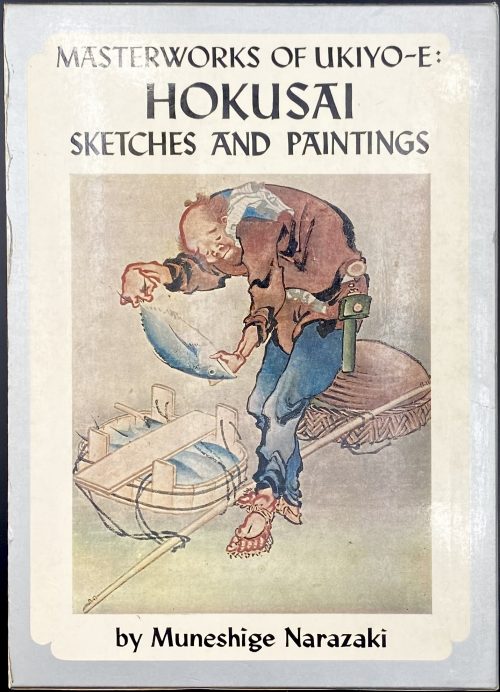 Hardcover volume from the series Masterworks of ukiyo-e, 26.1 x 19 cm, bound in canvas, red characters on black strip to front, red and black lettering to spine, tan embossed endpapers, in a pictorial slipcase with series design (black lettering on silver spine); pp: [1-6]: h.t./frontis. (colour plate pasted in), t.p./imprint, contents/acknowledgements), 7-16 text, 17-96 (79 plates w/captions). Title-page (in frame): MASTERWORKS OF UKIYO-E | HOKUSAI | SKETCHES AND PAINTINGS | by Muneshige Narazaki | English adaptation by John Bester | {publisher’s device} | KODANSHA INTERNATIONAL LTD. | Tokyo, Japan & Palo-Alto, Calif., U.S.A | {vertical, between rules 漫画肉筆画} || Series: Masterworks of ukiyo-e, № 7. Muneshige Narazaki [楢崎 宗重] (Japanese, 1904 – 2001) – author. Katsushika Hokusai [葛飾 北斎] (Japanese, 1760 – 1849) – artist. John Bester (British, 1927 – 2010) – adaptation.
Hardcover volume from the series Masterworks of ukiyo-e, 26.1 x 19 cm, bound in canvas, red characters on black strip to front, red and black lettering to spine, tan embossed endpapers, in a pictorial slipcase with series design (black lettering on silver spine); pp: [1-6]: h.t./frontis. (colour plate pasted in), t.p./imprint, contents/acknowledgements), 7-16 text, 17-96 (79 plates w/captions). Title-page (in frame): MASTERWORKS OF UKIYO-E | HOKUSAI | SKETCHES AND PAINTINGS | by Muneshige Narazaki | English adaptation by John Bester | {publisher’s device} | KODANSHA INTERNATIONAL LTD. | Tokyo, Japan & Palo-Alto, Calif., U.S.A | {vertical, between rules 漫画肉筆画} || Series: Masterworks of ukiyo-e, № 7. Muneshige Narazaki [楢崎 宗重] (Japanese, 1904 – 2001) – author. Katsushika Hokusai [葛飾 北斎] (Japanese, 1760 – 1849) – artist. John Bester (British, 1927 – 2010) – adaptation. -
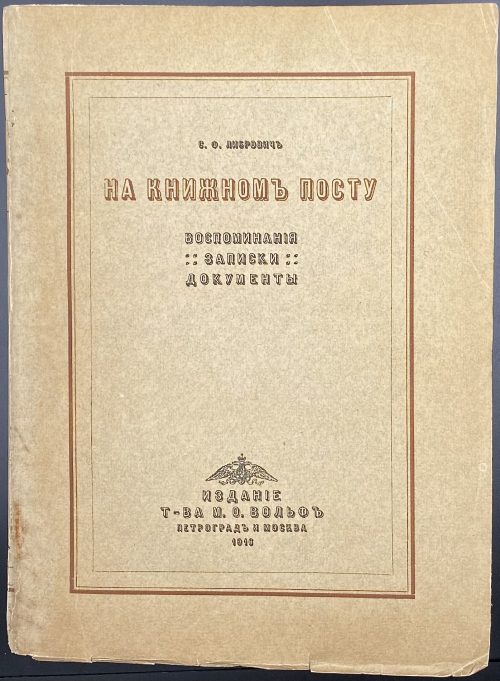 Softcover volume, 24.0 x 17.7 cm, publisher’s tan wrappers, lettered to front and spine in brown and black, publisher’s device and imprint to back, upper margin trimmed, all printed on laid paper, pp: [i-viii] [1-3] 4-496 [4], last page blank (total 508 pages); collated 8vo: π4 1-318 χ2 (total 254 leaves). Book-label with publisher’s device to fep (χ1 recto). Title-page and front wrapper (in brown and black): С. Ф. ЛИБРОВИЧЪ | НА КНИЖНОМЪ ПОСТУ | ВОСПОМИНАНIЯ | : : ЗАПИСКИ : : | ДОКУМЕНТЫ | {two-headed eagle} | ИЗДАНIЕ | Т-ВА М. О. ВОЛЬФЪ | ПЕТРОГРАДЪ И МОСКВА | (1916 on front wrapper) || Provenance: Publisher Contributors: Сигизмунд Феликсович Либрович [Zygmunt Librowicz] (Polish-Russian, 1855 – 1918) – author. Товарищество М. О. Вольф (Петроград-Москва) – publisher. Типография товарищества М. О. Вольф (Петроград) – printer. Маврикий Осипович Вольф [Maurycy Bolesław Wolff] (Polish-Russian, 1825 – 1883) – dedicatee.
Softcover volume, 24.0 x 17.7 cm, publisher’s tan wrappers, lettered to front and spine in brown and black, publisher’s device and imprint to back, upper margin trimmed, all printed on laid paper, pp: [i-viii] [1-3] 4-496 [4], last page blank (total 508 pages); collated 8vo: π4 1-318 χ2 (total 254 leaves). Book-label with publisher’s device to fep (χ1 recto). Title-page and front wrapper (in brown and black): С. Ф. ЛИБРОВИЧЪ | НА КНИЖНОМЪ ПОСТУ | ВОСПОМИНАНIЯ | : : ЗАПИСКИ : : | ДОКУМЕНТЫ | {two-headed eagle} | ИЗДАНIЕ | Т-ВА М. О. ВОЛЬФЪ | ПЕТРОГРАДЪ И МОСКВА | (1916 on front wrapper) || Provenance: Publisher Contributors: Сигизмунд Феликсович Либрович [Zygmunt Librowicz] (Polish-Russian, 1855 – 1918) – author. Товарищество М. О. Вольф (Петроград-Москва) – publisher. Типография товарищества М. О. Вольф (Петроград) – printer. Маврикий Осипович Вольф [Maurycy Bolesław Wolff] (Polish-Russian, 1825 – 1883) – dedicatee. -
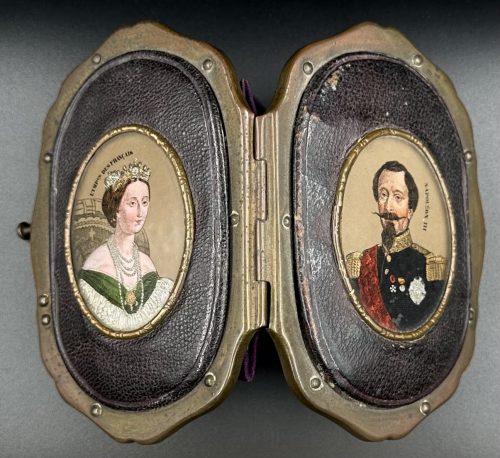 Coin purse, or porte-monnaie, made of patinated copper alloy, full-grain brown leather outside and purple inside, with a clutch and a hinge, and an oval miniature bust portrait on each side, painted in colour with gold and silver, by an anonymous artist after Franz Xaver Winterhalter, inscribed NAPOLÉON III and L'IMPCE DES FRANÇAIS, respectively, under glass. Dimensions: 97 x 67 x 18 mm. Contributors: Napoleon III [Charles Louis Napoléon Bonaparte] (French, 1808 – 1873) – character/sitter. Eugénie de Montijo [María Eugenia Ignacia Agustina de Palafox y Kirkpatrick] (Spanish-French, 1826 – 1920) – character/sitter. Franz Xaver Winterhalter (German, 1805 – 1873) – artist.
Coin purse, or porte-monnaie, made of patinated copper alloy, full-grain brown leather outside and purple inside, with a clutch and a hinge, and an oval miniature bust portrait on each side, painted in colour with gold and silver, by an anonymous artist after Franz Xaver Winterhalter, inscribed NAPOLÉON III and L'IMPCE DES FRANÇAIS, respectively, under glass. Dimensions: 97 x 67 x 18 mm. Contributors: Napoleon III [Charles Louis Napoléon Bonaparte] (French, 1808 – 1873) – character/sitter. Eugénie de Montijo [María Eugenia Ignacia Agustina de Palafox y Kirkpatrick] (Spanish-French, 1826 – 1920) – character/sitter. Franz Xaver Winterhalter (German, 1805 – 1873) – artist.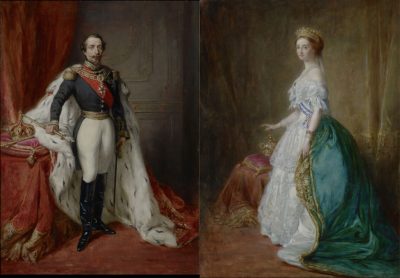
-
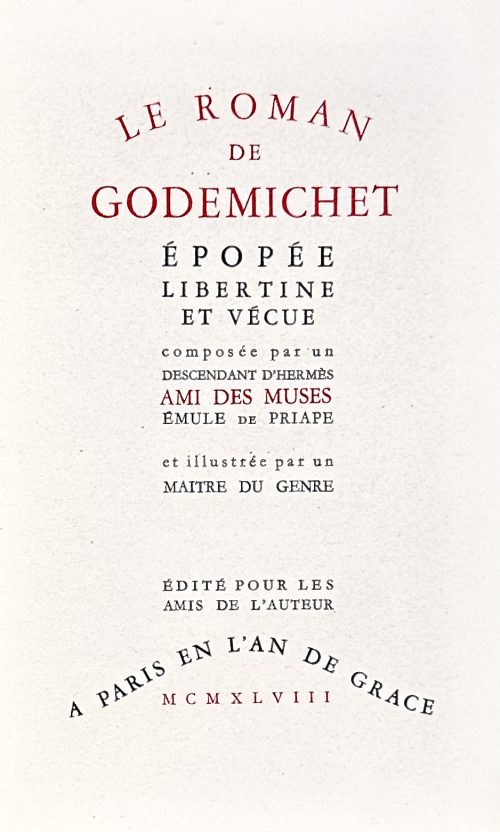 Softcover volume, 23.5 x 15 cm, in tan French flapped wrappers with red lettering to front, collated in-4to, in a tan double slipcase 24 x 15 cm with red lettered label to spine, pp.: [1-12] 13-112 [8], total 120 pages, incl. those within wrappers; printed on thick wove paper watermarked “Lafuma Frères”, 5 full-page and 6 half-page illustrations within collation, incl. frontispiece, guard tissue laid in. Title-page (red and black): LE ROMAN | DE | GODEMICHET | ÉPOPÉE | LIBERTINE | ET VÉCUE | composée par un | DESCENDANT D’HERMES | AMI DES MUSES | ÉMULE DE PRIAPE | et illustrée par un | MAITRE DU GENRE | ÉDITÉ POUR LES | AMIS DE L’AUTEUR | A PARIS EN L’AN DE GRACE | MCMXLVIII || Limited edition 200 + XX, this is copy № 175. Catalogue raisonné: Dutel III № 2336. Jean Reschofsky (French, 1905 – 1998) – artist.
Softcover volume, 23.5 x 15 cm, in tan French flapped wrappers with red lettering to front, collated in-4to, in a tan double slipcase 24 x 15 cm with red lettered label to spine, pp.: [1-12] 13-112 [8], total 120 pages, incl. those within wrappers; printed on thick wove paper watermarked “Lafuma Frères”, 5 full-page and 6 half-page illustrations within collation, incl. frontispiece, guard tissue laid in. Title-page (red and black): LE ROMAN | DE | GODEMICHET | ÉPOPÉE | LIBERTINE | ET VÉCUE | composée par un | DESCENDANT D’HERMES | AMI DES MUSES | ÉMULE DE PRIAPE | et illustrée par un | MAITRE DU GENRE | ÉDITÉ POUR LES | AMIS DE L’AUTEUR | A PARIS EN L’AN DE GRACE | MCMXLVIII || Limited edition 200 + XX, this is copy № 175. Catalogue raisonné: Dutel III № 2336. Jean Reschofsky (French, 1905 – 1998) – artist. -
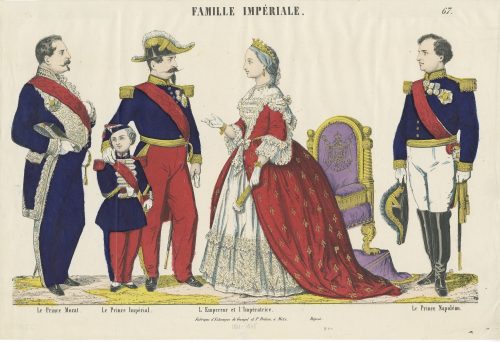 Hand-coloured woodcut on wove paper, 288 x 426 mm; black ink stamp “5305” to reverse. Top centre: "FAMILLE IMPÉRIALE", right: "67." Under the image: "Le Prince Murat." — "Le Prince Impérial." — "L' Empereur et l'Impératrice." — "Le Prince Napoléon." Bottom: "Fabrique d'Estampes de Gangel et P. Didion, à Metz." — "Déposé." Bottom: ms in pencil "1861 – 1868". Publisher/printer: Gangel et P. Didion (Metz); Paulin Didion (French, 1831 – 1879). Characters: Napoleon III [Charles-Louis Napoléon Bonaparte] (French, 1808 – 1873) Eugénie de Montijo [L'impératrice Eugénie] (Spanish-French, 1826 – 1920) Napoléon, Prince Imperial (Napoléon Eugène Louis Jean Joseph Bonaparte] (French, 1856 – 1879) Prince Murat [Lucien Charles Joseph Napoléon] (French, 1803 – 1878) Napoléon-Jérôme Bonaparte [Prince Napoléon] (French, 1822 – 1891)
Hand-coloured woodcut on wove paper, 288 x 426 mm; black ink stamp “5305” to reverse. Top centre: "FAMILLE IMPÉRIALE", right: "67." Under the image: "Le Prince Murat." — "Le Prince Impérial." — "L' Empereur et l'Impératrice." — "Le Prince Napoléon." Bottom: "Fabrique d'Estampes de Gangel et P. Didion, à Metz." — "Déposé." Bottom: ms in pencil "1861 – 1868". Publisher/printer: Gangel et P. Didion (Metz); Paulin Didion (French, 1831 – 1879). Characters: Napoleon III [Charles-Louis Napoléon Bonaparte] (French, 1808 – 1873) Eugénie de Montijo [L'impératrice Eugénie] (Spanish-French, 1826 – 1920) Napoléon, Prince Imperial (Napoléon Eugène Louis Jean Joseph Bonaparte] (French, 1856 – 1879) Prince Murat [Lucien Charles Joseph Napoléon] (French, 1803 – 1878) Napoléon-Jérôme Bonaparte [Prince Napoléon] (French, 1822 – 1891) -
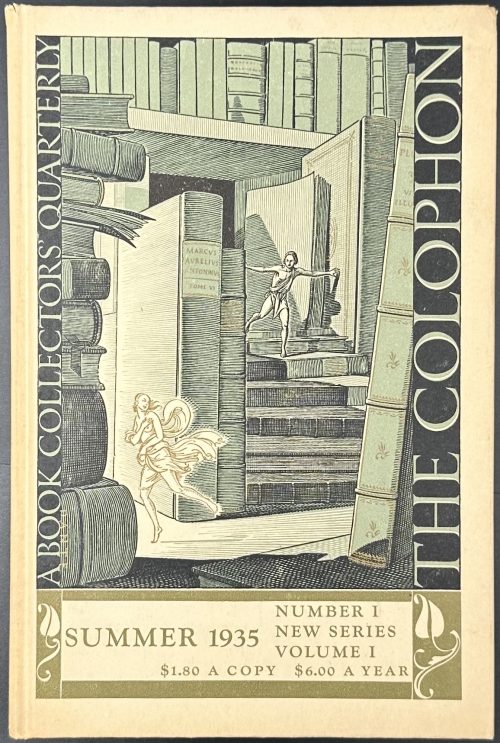
The Colophon, A Book Collectors' Quarterly
- The colophon (new series): A quarterly for bookmen / Summer 1935, № 1, vol. 1. — NY: Pynson Printers, 1935. Hardcover, 24 x 16 cm, paper boards, serial pictorial design; pp: [4 blanks] [6] 7-159 [160] [4 blanks]. THE | COLOPHON | new series | A QUARTERLY FOR BOOKMEN | {woodcut vignette} | — | SUMMER 1935 | VOLUME I • NEW SERIES • NUMBER 1 | NEW YORK, N. Y. ||
- The colophon (new series): A quarterly for bookmen / Autumn 1935, № 2, vol. 1. — NY: Pynson Printers, 1935. (2 copies). Hardcover, 24 x 16 cm, paper boards, serial pictorial design; pp: [4 blanks] [6] 167-315 [315] [4 blanks]. THE | COLOPHON | new series | A QUARTERLY FOR BOOKMEN | {woodcut vignette} | — | AUTUMN 1935 | VOLUME I • NEW SERIES • NUMBER 2 | NEW YORK ||
- The colophon (new series): A quarterly for bookmen / Autumn 1936, № 1, vol. 2. — NY: Pynson Printers, 1936. Hardcover, 24 x 16 cm, cloth serial design; pp: [4 blanks] [6] 7-157 [158] [4 blanks]. THE | COLOPHON | new series | A QUARTERLY FOR BOOKMEN | {woodcut vignette} | — | AUTUMN 1936 | VOLUME II • NEW SERIES • NUMBER 1 | NEW YORK ||
- The colophon (new series): A quarterly for bookmen / Winter 1936, № 3, vol. 1. — NY: Pynson Printers, 1936. (2 copies) Hardcover, 24 x 16 cm, paper boards, serial pictorial design; pp: [4 blanks] [6] 323-480 [4 blanks]. THE | COLOPHON | new series | A QUARTERLY FOR BOOKMEN | {woodcut vignette} | — | WINTER 1936 | VOLUME I • NEW SERIES • NUMBER 3 | NEW YORK ||
- The colophon (new series): A quarterly for bookmen / Autumn 1937, № 4, vol. 2. — NY: Pynson Printers, 1937. Hardcover, 24 x 16 cm, cloth serial design; pp: [4 blanks] [6] 487-628 [4 blanks]. THE | COLOPHON | new series | A QUARTERLY FOR BOOKMEN | {woodcut vignette} | — | AUTUMN 1937 | VOLUME II • NEW SERIES • NUMBER 4 | NEW YORK ||
- The colophon (new series): A quarterly for bookmen / Summer 1938, № 3, vol. 3. — NY: Pynson Printers, 1938. Hardcover, 24 x 16 cm, cloth new serial design; pp: [4 blanks] [6] 335-476 [4 blanks]. THE | COLOPHON | new series | A QUARTERLY FOR BOOKMEN | {woodcut vignette} | — | SUMMER 1938 | VOLUME III • NEW SERIES • NUMBER 3 | NEW YORK ||
- The colophon (new series): A quarterly for bookmen / Autumn 1938, № 4, vol. 3. — NY: Pynson Printers, 1938. Hardcover, 24 x 16 cm, cloth new serial design; pp: [4 blanks] [6] 483-632 [4 blanks]. THE | COLOPHON | new series | A QUARTERLY FOR BOOKMEN | {woodcut vignette} | — | AUTUMN 1938 | VOLUME III • NEW SERIES • NUMBER 4 | NEW YORK ||
-
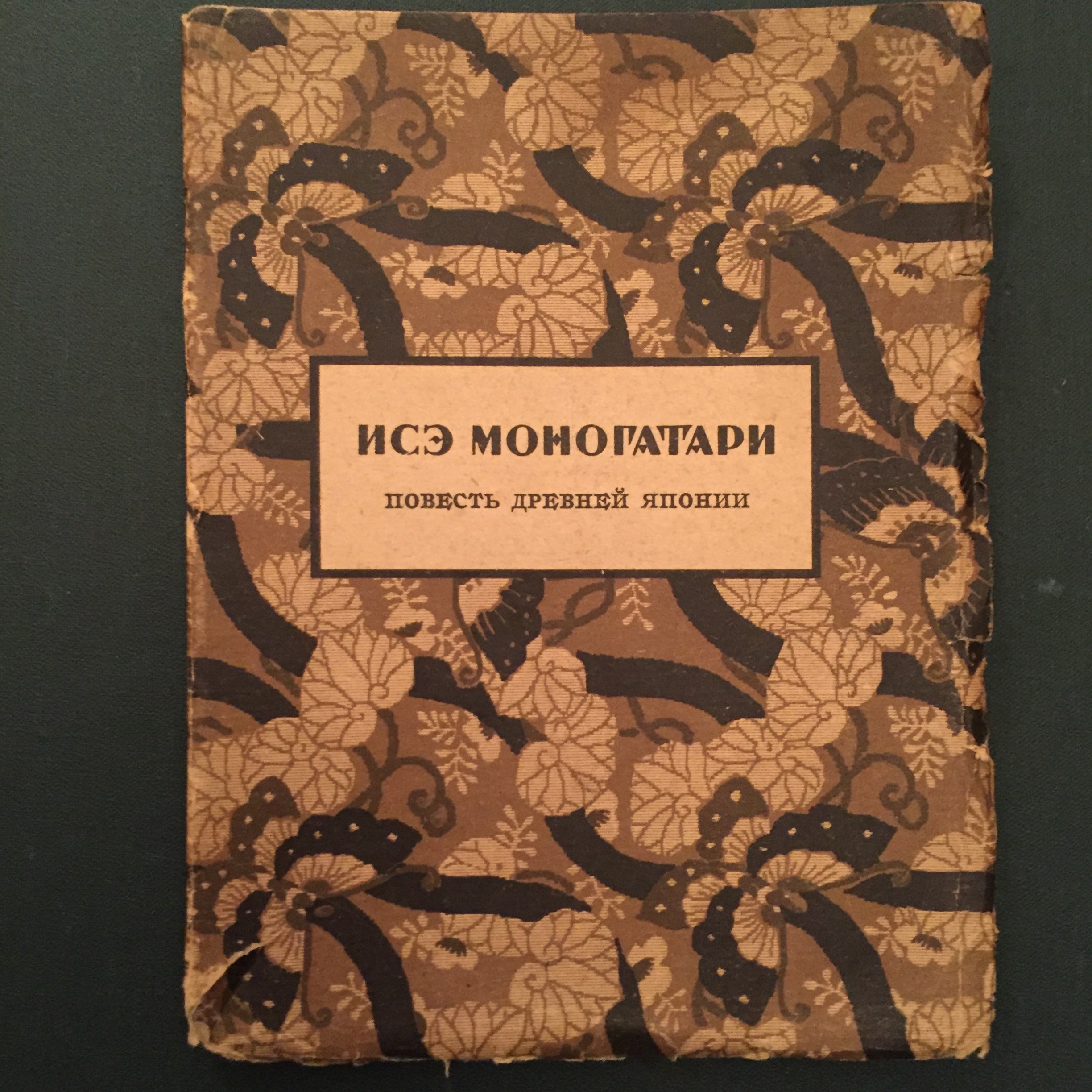
Исэ-Моногатари. Лирическая повесть древней Японии. Перевод и предисловие Н. Конрад. Гос. изд-во "Всемирная литература", 1923.
Перевод на русский язык (с японского издания 1912 года) был выполнен выдающимся советским востоковедом Н И. Конрадом и опубликован в 1923 году издательством «Всемирная литература». Неполностью разрезана, залита по краям, надрывы обложки.
-
 Artist: Utagawa Kunisada [歌川 国貞], a.k.a. Utagawa Toyokuni III [三代 歌川 豊国] (Japanese, 1786 – 1865). Signed: Toyokuni ga [豊国 画] in a red toshidama cartouche Block carver: Yokokawa Takejirō [横川竹二郎] (Japanese, fl. 1845 – 1863), seal: 彫竹 – hori Take. Publisher: Ibaya Senzaburō [伊場屋仙三郎] (Japanese, fl. c. 1845 – 1847). Media: Untrimmed fan print (uchiwa-e), 230 x 295 mm. Combined date seal and kiwame censor seal: Ansei 6 (1859). Title: Princess Sotoori [衣通姫] (Sotoori-hime) – Sotoori-hime was a concubine of Emperor Ingyo (reigned AD 412-53), and one of the Three Gods of Japanese Poetry [和歌三神] (Waka sanjin). Series: Chronicles of Elegant Women [風雅女史傳] (Fūga joshiden). The sign on the torii (Shinto shrine gates) reads: Mountain king shrine [山王宮] – it is the Sannō Shrine at the Nagata Riding Grounds in Edo. A print with these gates is at MFA (Boston) # 21.9853.
Artist: Utagawa Kunisada [歌川 国貞], a.k.a. Utagawa Toyokuni III [三代 歌川 豊国] (Japanese, 1786 – 1865). Signed: Toyokuni ga [豊国 画] in a red toshidama cartouche Block carver: Yokokawa Takejirō [横川竹二郎] (Japanese, fl. 1845 – 1863), seal: 彫竹 – hori Take. Publisher: Ibaya Senzaburō [伊場屋仙三郎] (Japanese, fl. c. 1845 – 1847). Media: Untrimmed fan print (uchiwa-e), 230 x 295 mm. Combined date seal and kiwame censor seal: Ansei 6 (1859). Title: Princess Sotoori [衣通姫] (Sotoori-hime) – Sotoori-hime was a concubine of Emperor Ingyo (reigned AD 412-53), and one of the Three Gods of Japanese Poetry [和歌三神] (Waka sanjin). Series: Chronicles of Elegant Women [風雅女史傳] (Fūga joshiden). The sign on the torii (Shinto shrine gates) reads: Mountain king shrine [山王宮] – it is the Sannō Shrine at the Nagata Riding Grounds in Edo. A print with these gates is at MFA (Boston) # 21.9853. Other prints from the same series in this collection:
SVJP-0343.2021 — Tamagiku:
Other prints from the same series in this collection:
SVJP-0343.2021 — Tamagiku:
 SVJP-0400.2023 — Saiko:
SVJP-0400.2023 — Saiko:
 Note: Special thanks to Horst Graebner, who helped decipher and understand the meaning.
Note: Special thanks to Horst Graebner, who helped decipher and understand the meaning.
-
 Artist: Utagawa Toyokuni I [歌川豊国] (1769–1825). Title: 「しなのやおこん 瀬川菊之丞」「帯屋長右衛門 嵐雛助」 Kabuki play: Katsuragawa Renri no Shigarami [桂川連理柵]. According to Waseda University Cultural Resource Database, the play was performed at Ichimura-za (Edo) on the 2nd month of Kansei 12 (year 1800) under the title 楼門五山桐 さんもんごさんのきり. Publisher: Nishimuraya Yohachi [西村屋与八] (Japanese, c. 1751 – 1869)., Play by Suga Sensuke [菅専助] (ca. 1728 – 1791) in two acts. First performed at Kita Horie-za in Osaka in October 1776. Based on a real incident occurring sometime in the Kyōhō era (1716-35), this story was first dramatized in 1761. The first Kabuki drama to stem from this play was in 1777 at Osaka's Araki-za. Obiya Chōemon, a married obi merchant (sitting with abacus) in his forties, meets his neighbour's daughter Ohan (standing behind Obiya), who is young enough to be his daughter, at an inn in Ishibe; the two fall in love and pledged their troth. Ohan becomes pregnant. After a series of misfortunes, the lovers rush to Katsuragawa (Katsura River), where they drown themselves.
Artist: Utagawa Toyokuni I [歌川豊国] (1769–1825). Title: 「しなのやおこん 瀬川菊之丞」「帯屋長右衛門 嵐雛助」 Kabuki play: Katsuragawa Renri no Shigarami [桂川連理柵]. According to Waseda University Cultural Resource Database, the play was performed at Ichimura-za (Edo) on the 2nd month of Kansei 12 (year 1800) under the title 楼門五山桐 さんもんごさんのきり. Publisher: Nishimuraya Yohachi [西村屋与八] (Japanese, c. 1751 – 1869)., Play by Suga Sensuke [菅専助] (ca. 1728 – 1791) in two acts. First performed at Kita Horie-za in Osaka in October 1776. Based on a real incident occurring sometime in the Kyōhō era (1716-35), this story was first dramatized in 1761. The first Kabuki drama to stem from this play was in 1777 at Osaka's Araki-za. Obiya Chōemon, a married obi merchant (sitting with abacus) in his forties, meets his neighbour's daughter Ohan (standing behind Obiya), who is young enough to be his daughter, at an inn in Ishibe; the two fall in love and pledged their troth. Ohan becomes pregnant. After a series of misfortunes, the lovers rush to Katsuragawa (Katsura River), where they drown themselves.Segawa Kikunojō III (Japanese, 1751 – 1810); other names: Segawa Senjo, Segawa Rokō III, Segawa Tomisaburō I, Ichiyama Tomisaburō, Ichiyama Shichinosuke. The actor held the name of Segawa Kikunojō III from the 11th lunar month of 1774 to the 7th lunar month of 1801. He surpassed all the actors of his time in both female and male roles, especially in the former, and achieved tremendous public acclaim.
Arashi Hinasuke II [嵐雛助] (Japanese, c. 1774 – 1801); other names: Nakamura Jūzō III, Kanō Hidenosuke I, Arashi Hidenosuke I. The actor held the name of Arashi Hinasuke II from the 1st lunar month of 1794 to the 2nd lunar month of 1801. Hi died in Edo on the 4th day of the 2nd lunar month of 1801. For the same characters illustrated by Utagawa Kuniyoshi see SVJP-0333.2021. Sources:
Sources:
- Historical Dictionary of Japanese Traditional Theatre By Samuel L. Leiter. Second edition, 2014.
- Kabuki Encyclopedia. An English-Langauge Adaptation of Kabuki Jiten. Samuel L. Leiter. Greenwood Press, 1979.
- http://www.kabuki21.com/
- Waseda University Cultural Resource Database
-
 Iron tsuba of round form with design of iris and snowflake in openwork (ko-sukashi or small cut-outs) outlined with brass wire. Three concentric rows of brass dots (ten-zōgan), with a brass circular line inside the innermost row of dots (missing on the back). Hitsu-ana is not outlined with brass wire, which let us suppose that it was cut out at a later date. Iron and brass. Ko-sukashi and ten-zōgan technique. Mid Muromachi period (1454-1513). Height: 74.0 mm, Width: 73.6 mm, Thickness: 3.0 mm.
Iron tsuba of round form with design of iris and snowflake in openwork (ko-sukashi or small cut-outs) outlined with brass wire. Three concentric rows of brass dots (ten-zōgan), with a brass circular line inside the innermost row of dots (missing on the back). Hitsu-ana is not outlined with brass wire, which let us suppose that it was cut out at a later date. Iron and brass. Ko-sukashi and ten-zōgan technique. Mid Muromachi period (1454-1513). Height: 74.0 mm, Width: 73.6 mm, Thickness: 3.0 mm.NBTHK certification of 1968: "Kicho". Condition is relatively poor: rust, missing inlay, scratches.
While representation of the snowflake is rather standard, the meaning of the other cut-out design was initially less clear. Similar symbol was found at (1) "Kokusai Tosogu Kai, International Convention & Exhibition, September 24-25, 2005, The Frazier Historical Arms Museum, Louisville, Kentucky, USA"; on page 21 there is a photograph J-6 of a ko-tosho tsuba with "iris theme openwork"; (2) Japanese Swords and Tsuba from the Professor A. Z. Freeman and the Phyllis Sharpe Memorial collections. Sotheby's, London, Thursday 10 April 1997; page 11, lot 6 - a ko-katchushi tsuba of early Muromachi period fith "simple design of stylized iris". In both sources the symbol is explained as 'iris" (kakitsubata).
Freeman and Sharpe collections. Sotheby's, 1997.

Kokusai Tosogu Kai, September 24-25, 2005.
-
 Round tsuba of iron; well forged thin plate decorated with a rudder (kaji) and an oar, or paddle (kai) with a water drop, executed in a combination of negative (in-sukashi) and positive (ji-sukashi) openwork. It may be Ko-Tōshō (old Tōshō) or just Tōshō school, without a 'Ko'. The characteristics of the plate point toward an older piece, however the combination of negative and positive silhouettes pulls the date of manufacture in an opposite direction. Muromachi period. Height: 90.0 mm. Width: 89.0 mm. Rim thickness: 2.1 mm. Center thickness: 2.3 mm. Nakago-ana: height = 29 mm, width = 8.8 mm. A rudder and an oar design is classified by John W. Dower as "Sailing vessels and gear": "Unlike many other motifs, sailing vessels and sailing gear failed to collect an interesting lore or to develop levels of meaning." Merrily Baird does not say anything about these symbols. Yuzuri Okada says: "Ships, sails, rudders, etc. also supply motive of the same class as wheels." He does not provide us with the description of the motive supplied by the wheel. The same motif is used on Ōnin tsuba in this collection:
Round tsuba of iron; well forged thin plate decorated with a rudder (kaji) and an oar, or paddle (kai) with a water drop, executed in a combination of negative (in-sukashi) and positive (ji-sukashi) openwork. It may be Ko-Tōshō (old Tōshō) or just Tōshō school, without a 'Ko'. The characteristics of the plate point toward an older piece, however the combination of negative and positive silhouettes pulls the date of manufacture in an opposite direction. Muromachi period. Height: 90.0 mm. Width: 89.0 mm. Rim thickness: 2.1 mm. Center thickness: 2.3 mm. Nakago-ana: height = 29 mm, width = 8.8 mm. A rudder and an oar design is classified by John W. Dower as "Sailing vessels and gear": "Unlike many other motifs, sailing vessels and sailing gear failed to collect an interesting lore or to develop levels of meaning." Merrily Baird does not say anything about these symbols. Yuzuri Okada says: "Ships, sails, rudders, etc. also supply motive of the same class as wheels." He does not provide us with the description of the motive supplied by the wheel. The same motif is used on Ōnin tsuba in this collection:
-
 Iron tsuba of round form with slanting rays of light (shakoh) Christian motif (Jesuit's IHS symbol) in openwork (sukashi). Traditional description of this kind of design is called "tokei", or "clock gear". Edo period.
Iron tsuba of round form with slanting rays of light (shakoh) Christian motif (Jesuit's IHS symbol) in openwork (sukashi). Traditional description of this kind of design is called "tokei", or "clock gear". Edo period.Size: 83.4 x 83.1 x 4.4 mm
Signed Bushū-jū Ujishige saku (武州住氏重作) [Markus Sesko]. Ujishige (died 1677), 3rd generation of the Katsuki-Gondayu line; 1st gen. Ujiie came from Kyoto to Kaga to work for the Maeda family. There was another Ujishige, 4th generation Kaneko (?), who died in 1867 [M. Sesko, Genealogies...], but this tsuba looks a bit earlier than that. This particular Ujishige states in his signature that he is from Bushū, or Musashi Province, modern Tokyo Metropolis. He might have moved from Bushū to Kaga, of course. There is no artist with the name Ujishige in Bushū-Ito School anyway.
For information regarding shakoh tsuba see article 'Kirishitan Ikenie Tsuba by Fred Geyer at Kokusai Tosogu Kai; The 2nd International Convention & Exhibition, October 18-23, 2006, pp. 84-91. -
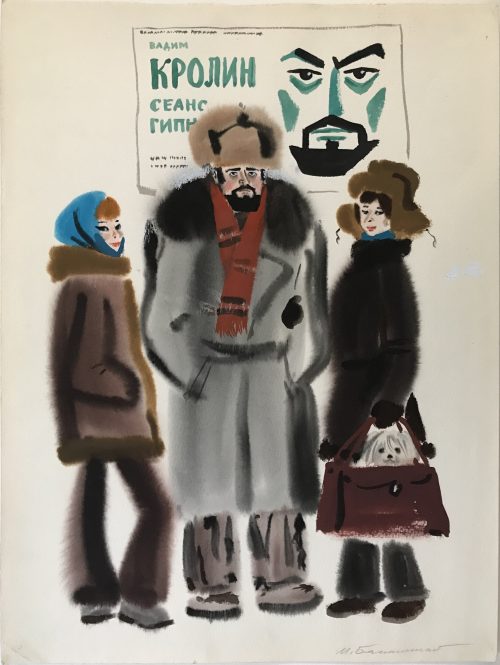 Mikhail Belomlinsky. Born 1934, Russia. Vadim Krolin, hypnosis session. Watercolor painting on paper from Chukotka expedition, ca. 1970s. Size: 36 x 48 cm.
Mikhail Belomlinsky. Born 1934, Russia. Vadim Krolin, hypnosis session. Watercolor painting on paper from Chukotka expedition, ca. 1970s. Size: 36 x 48 cm. -

Circular tsuba (marugata ) with design of futatsu-domoe (twofold tomoe) in negative openwork (kage-sukashi), folded-over rim (uchikaeshi-mimi ). The ‘head’ of the left tomoe altered to form an opening for scabbard accessory (kata-hitsu-ana), adorned with gold ategane fitting with file marks (tate-yasurime). The hammer-blow finish of the surface (tsuchime-ji). Signed to the left of nakaga-ana: Yamakichibei (山吉兵). Attributed by Steve Waszak a the Second Generation (Nidai) master.
NBTHK paper [translated by Markus Sesko]:Tomoe-sukashi-tsuba (巴透し鐔).
KANTEI-SHO (鑑定書) - APPRAISAL No 451718
Futatsu-domoe sukashi-tsuba (二巴透鐔) ‒ Tsuba with two tomoe comma openwork design
Signed: Yamakichibei (山吉兵)
Round shape (marugata ), iron, hammerblow finish (tsuchime-ji ), negative openwork design (kage-sukashi ), folded-over rim (uchikaeshi-mimi ), one opening for scabbard accessory
(kata-hitsu-ana) (with gold ategane fitting)
According to the result of the shinsa committee of our society, we judge this work as authentic
and rank it as Hozon Tōsōgu.
February 20, 2007
[Foundation] Nihon Bijutsu Tōken Hozon Kyōkai, NBTHK (日本美術刀劍保存協會)
Diameter: 76 mm, thickness at center 3.9 mm, thickness at rim: 5.1 mm; weight: 102.5 g
Tomoe (Comma): The character 巴 (Chinese pronunciation bā). A pattern resembling the two-comma tomoe (futatsu-domoe) has been found in ancient cultures on all inhabited continents. ...aside from their military function, a ritual or fetish value, perhaps related to their testicular shape. It also has yin-yang connotation. The gold sekigane confirms the high value of the piece to the owner.
-
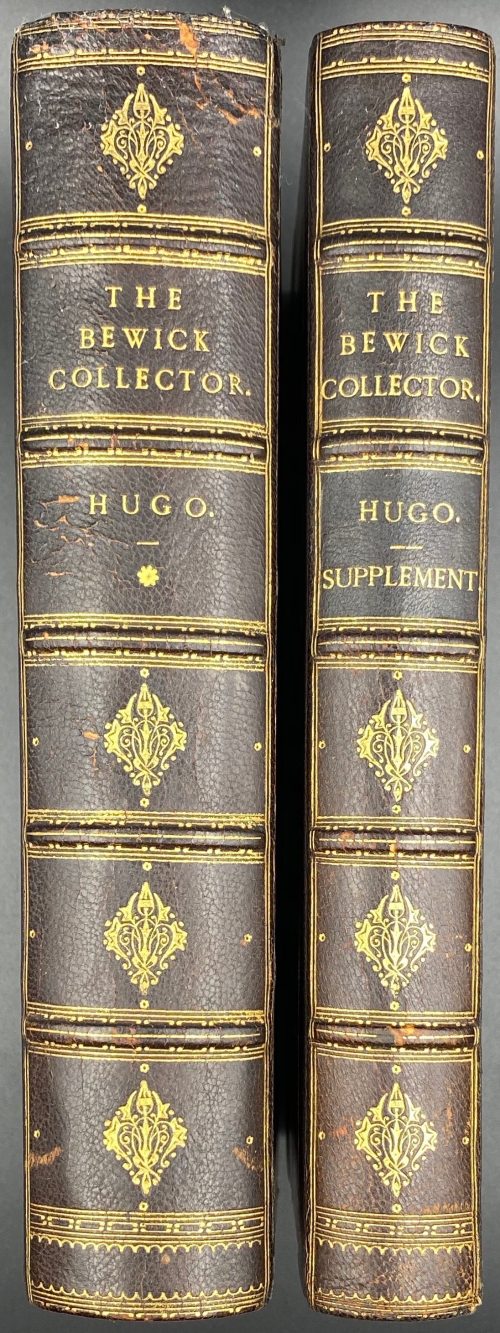 A two-volume set: (1) Thomas Hugo. The Bewick Collector. A Descriptive Catalogue of the Works of Thomas and John Bewick; Including cuts, in various states, for Books and Pamphlets, Private Gentlemen, Public Companies, Exhibitions, Races, Newspapers, Shop Cards, Invoice Heads, Bar Bills, Coal Certificates, Broadsides, and other miscellaneous purposes, and Wood Blocks. With an Appendix of Portraits, Autographs, Works of Pupils, etc., etc. The whole described from the Originals contained in the largest and most perfect collection ever formed, and illustrated with a hundred and twelve cuts. — London: Lovell Reeve and Co., MDCCCLXVI [1866]. — [Printed by] J. E. Taylor and Co., printers. — pp.: [i-v] vi-xxiii [xxiv], [1] 2-562. (2) Thomas Hugo. The Bewick Collector. A Supplement to a Descriptive Catalogue of the Works of Thomas and John Bewick; Consisting of additions to the various divisions of cuts, wood blocks. etc., enumerated in that work. The whole described from the Originals contained in the largest and most perfect collection ever formed, and illustrated with a hundred and eighty cuts. — London: L. Reeve and Co, MDCCCLXVIII [1868]. — [Printed by] J. E. Taylor and Co., printers. — pp.: [i-vii] viii-xxxii, [1] 2-353. Both volumes in 8vo, 22.5 x 14.5 cm, hardcover. Contemporary dark brown half morocco, gilt-ruled, with 5 raised bands, gilt titles and decoration to spine, and marbled paper over boards. Top edge gilt; marbled endpapers. Binding splitting at pp.80/81 of the 1st volume. Armorial bookplate of Ralph Hart Tweddle to front pastedown. Ralph Hart Tweddle (1843 – 1895) was a British mechanical engineer, known particularly for inventing the portable hydraulic riveter, which greatly facilitated the construction of boilers, bridges and ships.
A two-volume set: (1) Thomas Hugo. The Bewick Collector. A Descriptive Catalogue of the Works of Thomas and John Bewick; Including cuts, in various states, for Books and Pamphlets, Private Gentlemen, Public Companies, Exhibitions, Races, Newspapers, Shop Cards, Invoice Heads, Bar Bills, Coal Certificates, Broadsides, and other miscellaneous purposes, and Wood Blocks. With an Appendix of Portraits, Autographs, Works of Pupils, etc., etc. The whole described from the Originals contained in the largest and most perfect collection ever formed, and illustrated with a hundred and twelve cuts. — London: Lovell Reeve and Co., MDCCCLXVI [1866]. — [Printed by] J. E. Taylor and Co., printers. — pp.: [i-v] vi-xxiii [xxiv], [1] 2-562. (2) Thomas Hugo. The Bewick Collector. A Supplement to a Descriptive Catalogue of the Works of Thomas and John Bewick; Consisting of additions to the various divisions of cuts, wood blocks. etc., enumerated in that work. The whole described from the Originals contained in the largest and most perfect collection ever formed, and illustrated with a hundred and eighty cuts. — London: L. Reeve and Co, MDCCCLXVIII [1868]. — [Printed by] J. E. Taylor and Co., printers. — pp.: [i-vii] viii-xxxii, [1] 2-353. Both volumes in 8vo, 22.5 x 14.5 cm, hardcover. Contemporary dark brown half morocco, gilt-ruled, with 5 raised bands, gilt titles and decoration to spine, and marbled paper over boards. Top edge gilt; marbled endpapers. Binding splitting at pp.80/81 of the 1st volume. Armorial bookplate of Ralph Hart Tweddle to front pastedown. Ralph Hart Tweddle (1843 – 1895) was a British mechanical engineer, known particularly for inventing the portable hydraulic riveter, which greatly facilitated the construction of boilers, bridges and ships. -
 Magazine article by Edgar Jepson: The Iron Tsuba of Japan (Section: Oriental Art), published in volume Vol. 70 (September–December) of The Connoisseur: An Illustrated Magazine for Collectors, Vol. 70 (September–December); pp. 143-152 / C. Reginald Grundy [ed.] — London: Published by the Proprietor, W. CLAUSE JOHNSON, at the Editorial and Advertisement Offices of The Connoisseur, 1924. Owner's half black morocco, gilt lettering to spine, blue cloth boards. Two volumes bound together without original covers. Size 28.5 x 22 cm. Vol. 1: The Connoisseur | An Illustrated Magazine | For Collectors | Edited by C. Reginald Grundy | Vol. LXIX. | (MAY—AUGUST, 1924) | LONDON | Published by the Proprietor, W. CLAUSE JOHNSON, at the | Editorial and Advertisement Offices of The Connoisseur, | at 1, Duke Street, St. James's, S.W. 1 | 1924 || Pp.: [i-ii] iii-xviii [xix] [1, 2 - plate] 3-249 [250]. Vol. 2: The Connoisseur | An Illustrated Magazine | For Collectors | Edited by C. Reginald Grundy | Vol. LXX. | (SEPTEMBER—DECEMBER, 1924) | LONDON | Published by the Proprietor, W. CLAUSE JOHNSON, at the | Editorial and Advertisement Offices of The Connoisseur, | at 1, Duke Street, St. James's, S.W. 1 | 1924 || Pp.: [i-ii] iii-xxii [2 blanks] [1, 2 - plate] 3-261 [262]. The Iron Tsuba of Japan by Edgar Jepson The heart of Japan was in the sword. However admirable may be the paintings, the prints, the netsuke, the lacquer, or the bronzes of the Japanese masters, the supreme artistic achievements of Japan were the blades of Masamune, Muramasa, Sadamune, and Rai Kunitsugu. But not a little of the heart of Japan went also in the tsuba, the guard which protected the hand that wielded the blade, into the iron tsuba of the fighting Samurai. Beside the forgers of the iron tsuba of Japan the ironsmiths of the rest of the world have been mere children. The earliest tsuba were of bronze or copper, often gilded. It is probable that they were replaced by iron tsuba during the Kamakura period, the great fighting era, which lasted from A.D. 1185 to 1333. During the later half of the twelfth century leather tsuba, strengthened by thin iron plates or a metal rim, also replaced the bronze and copper tsuba. It was at this time that a family of armourers of the name of Masuda, and in particular Masuda Munesuke, the founder of the Myochin family, began to forge iron tsuba — thin, round plates of great hardness and density. But it is probable that no tsuba perforated with a view to decorative effects were forged before the end of the fourteenth century. These fourteenth-century tsuba are exceedingly rare in England. I have seen none in the museums, none in the famous collections that have been sold during the last ten years. Those photographed in Herr Oeder's book might easily be the fifteenth century. No. 1 is a curious cup-shape tsuba decorated with a bronze and copper inlay. No. 2, with its edges curiously twisted in the forging, looks like Myochin work. But it is not of the Myochin iron. The Myochin family produced some of the greatest ironsmiths of Japan. Armourers first of all, tsubasmiths, forgers of sake-kettles, articulated reptiles, crustacea, and insects — everything that can be done with iron they did; they pushed their medium to its limit. They were forging iron tsuba in 1160, and they were still forging them in 1860. And it was their own iron, or rather their own steel. They discovered the secret of it early, and they kept that secret in the family for all those hundreds of years. There is no mistaking a Myochin tsuba: balance it on your finger and tap it with a piece of metal, always it gives forth a clear bell-like ring that you get from the work of no other ironsmith, Japanese or European. Always the Myochin tsuba is before everything a protection to the hand of the swordsman; to that everything is, as it should be, subordinated. No. 3 is a Myochin tsuba of the fifteenth century, and probably of the early fifteenth century. No. 4, by Myochin Munetaka, perforated with a grotesque figure, is an example of that twisting and twisting of the iron in the forging till it forms a pattern like the grain of wood. The Myochin smiths invented these wood-grain tsuba, and no other smiths equalled them in their forging. In the sixteenth century, the fighting tsuba was probably at its best. It was a century of great tsubasmiths. Then the first Nobuiye, whose tsuba fetched £100 apiece, circa 1800, in Japan, and the first Kaneiye flourished. No. 5 is a tsuba forged by a great smith, Iyesada of Sotome, in the manner of Nobuiye I, decorated with the karakusa tendrils that Nobuiye delighted in, with lightning and clouds. No. 6 is a guard of Sanada Tembo, the chief smith of the Tembo family, stamped, punning fashion, with the character Tembo. Akin to the Tembo tsuba were those of the Kiami and Hoan smiths. Then also the Heianjo smiths and the Owari smiths, especially those of Nagoya and the Yamakichi family, forged their strongest tsuba. Those of the Yamakichi were tested after the forging by being pounded in iron mortars — at least, so the legend runs. But they were a sternly utilitarian family, and I have never seen a Yamakichi tsuba of any beauty. In the later half of the fifteenth century arose the fashion of decorating tsuba with an inlay, zogan, of bronze. The Heianjo tsuba, forged at Kyoto in the latter half of the fifteenth and the beginning of the sixteenth century, were often thus inlaid. The earliest of them were called "Onin", of which No. 7 is an example. In addition to the bronze inlay around the edge, it is inlaid with a representation, some say, of snow; others say, of the duckweed on a pond. No. 8 is probably a Heianjo tsuba, but I am not quite sure about it. The inlaid acacia branches might be very early Shoami work. But to judge by the iron, it is a fifteenth-century tsuba; and the authorities place the beginning of the Shoami school not later than early in the sixteenth century. No. 10 is an example of the Fushimi-zogan, a flat inlay of a light-coloured bronze. These tsuba took their name from the fact that they were first forged at Fushimi, in Yamashiro, in the sixteenth century. It is of the type known as Mon-zukashi, perforated with crests (mon) à jour. The Yoshiro-zogan tsuba were also first forged at Fushimi by Yoshiro Naomasa. They were distinguished from the Fushimi-zogan by the fact that their inlay was generally a little raised-not always-for the inlay of No. 9, a tsuba forged by a later nineteenth-century Yoshiro, is quite flat. It is an interesting tsuba, for, with its decoration grown florid and excessive, it marks the intermediate stage between the simple and delightful designs of the genuine fighting tsuba and the elaborate pictures in gold and silver on the tsuba of the eighteenth-century smiths of Awa and Kyoto, which have become mere ornaments of the goldsmith. The Gomoku-zogan (No. 11) tsuba were probably first forged earlier than the Fushimi and Yoshiro-zogan tsuba. This inlay, in slight relief, is a representation in a light-coloured bronze and copper of twigs caught in the eddies of streams. The seventeenth century and early eighteenth century were the great periods of perforated tsuba. The designs, and they are often admirable, are for the most part in plain fretwork; but they are also chased. No. 12, a crane under an acacia, is a tsuba of a Higo smith, great forgers of fighting tsuba during this period. These smiths also excelled in nunome zogan, a very thin gold and silver inlay, with which they further decorated their perforated guards. The smiths of the Umetada and Shoami families also forged iron tsuba during this period; but their designs, though sometimes pleasing enough, are rarely fine. The best work of Myoju Umetada is in sentoku, not iron. The Choshu smiths, coming later, surpass the perforated guards of both the Umetada and Shoami smiths in beauty of design. No. 13, a lotus in the round, not only fretwork, but also engraved, is a good example of the admirable balance they so often attained in their designs. It is a sufficiently realistic lotus, but yet of a delightful simplicity. In considerable contrast is No. 14, the dragon by Soheishi Soten — one of the only two authentic tsuba of his forging known — the first forger of hikone-bori tsuba, which were in extraordinary favour in Japan during the eighteenth century, and illustrated every important event in Japanese history. It is on the elaborate side, but fine, strong work, and an excellent guard to the hand, for the lighter and more open part, which gives the design its admirable balance, is on the inside, and not exposed to the full swing of an opponent's blade. A few years ago there was a tendency to decry the Namban tsuba as having sprung too directly from foreign sources. But though the original suggestion may have been Chinese, or, as some say, Portuguese, the Japanese made it entirely their own, as characteristically Japanese as anything can well be, but, it must be admitted, of a decadent period. The school took its rise at the beginning of the seventeenth century, and the early tsuba were forged of a specially hard iron, the Wootz, imported from Southern India. No. 15, the signs of the Zodiac, is an excellent tsuba from the fighting point of view. Both it and No. 16 are of quite charming, if elaborate, design, and both of them, with their delicate scroll-work, so astonishingly undercut, are the very last word in the work of the ironsmith-veritable iron lace. To return to the simpler perforated tsuba, the smiths of Akasaka, a suburb of Tokyo, produced probably the most charming designs. Their style derives considerably from the Higo smiths, and their earlier fighting tsuba are very like the Higo tsuba. But always their work was just a little lighter than that of the Higo smiths, and in the end they moved right away from them and became the forgers of very light guards indeed. No. 17, is a representation of the Hiyokudori, the fabulous double bird, in which were reincarnated the souls of the two lovers, Gompachi and Komurasaki; and No. 18, “the tsuba of a hundred ducks "— there are about forty — are characteristic designs of the school. In the work of the Akasaka smiths the balance, which makes the design of a good tsuba so admirable and delightful, attains its height. This admirable balance seems often to be obtained by a deliberate sacrifice of symmetry. About nine hundred and ninety-nine European ironsmiths out of a thousand would have made the right and left sides of the Hiyoku-dori line by line, and perforation by perforation, exactly alike; he would have cut out exactly as many ducks on the one side of “the tsuba of a hundred ducks” as on the other, and made each duck on the right side correspond exactly in position and attitude with a duck on the left side. By variations the tsubasmith attained a finer balance, almost a higher symmetry. No. 19, often called by collectors the "rose-window" tsuba, but really a stylised chrysanthemum, is a favourite design of the Akasaka smiths, but Hizen work and inlaid in the Hizen manner with gold nunome. No. 20 is a Satsuma tsuba of the middle period. The Satsuma smiths of the nineteenth century produced probably the most ornate of all the iron guards, for the most part calibashes and beans with their leaves and tendrils realistic in the extreme, but of charming design. Few crafts have been carried further than that of the tsubasmith; few crafts working in a difficult medium have handled more subjects with greater feeling for beauty or greater liveliness of fancy. It is interesting to note again and again how school influences school, and smith influences smith. But, as in all the applied arts, the finest tsuba were forged by men who never lost sight of the purpose of a tsuba, that it is before everything a protection to the hand, and never subjected that purpose to a passion for virtuosity. Illustrations: No 1. FOURTEENTH-CENTURY TSUBA, WITH BRONZE AND COPPER INLAY No. 2. FOURTEENTH-CENTURY TSUBA, RESEMBLING MYOCHIN WORK No. 3. MYOCHIN TSUBA, FIFTEENTH CENTURY No. 4. MYOCHIN TSUBA, NINETEENTH CENTURY No. 5. SIXTEENTH-CENTURY TSUBA No. 6. SIXTEENTH-CENTURY TSUBA BY IYESADA OF SOTOME BY SANADA TEMBO No. 7. ONIN TSUBA No. 8. HEIANJO (?) TSUBA No. 9. YOSHIRO TSUBA, NINETEENTH CENTURY No. 10. FUSHIMI-ZOGAN, NINETEENTH CENTURY No. 11.- GOMOKU-ZOGAN, SIXTEENTH CENTURY No. 12. HIGO TSUBA, SEVENTEENTH CENTURY No. 13. CHOSHU TSUBA, SEVENTEENTH CENTURY No. 14. SOTEN TSUBA, SEVENTEENTH CENTURY No. 15. NAMBAN TSUBA, EIGHTEENTH CENTURY No. 16. NAMBAN TSUBA, NINETEENTH CENTURY Nos. 17. AND 18. AKASAKA TSUBA, EIGHTEENTH CENTURY No. 19. HIZEN TSUBA, EIGHTEENTH CENTURY No. 20. SATSUMA TSUBA, EIGHTEENTH CENTURY
Magazine article by Edgar Jepson: The Iron Tsuba of Japan (Section: Oriental Art), published in volume Vol. 70 (September–December) of The Connoisseur: An Illustrated Magazine for Collectors, Vol. 70 (September–December); pp. 143-152 / C. Reginald Grundy [ed.] — London: Published by the Proprietor, W. CLAUSE JOHNSON, at the Editorial and Advertisement Offices of The Connoisseur, 1924. Owner's half black morocco, gilt lettering to spine, blue cloth boards. Two volumes bound together without original covers. Size 28.5 x 22 cm. Vol. 1: The Connoisseur | An Illustrated Magazine | For Collectors | Edited by C. Reginald Grundy | Vol. LXIX. | (MAY—AUGUST, 1924) | LONDON | Published by the Proprietor, W. CLAUSE JOHNSON, at the | Editorial and Advertisement Offices of The Connoisseur, | at 1, Duke Street, St. James's, S.W. 1 | 1924 || Pp.: [i-ii] iii-xviii [xix] [1, 2 - plate] 3-249 [250]. Vol. 2: The Connoisseur | An Illustrated Magazine | For Collectors | Edited by C. Reginald Grundy | Vol. LXX. | (SEPTEMBER—DECEMBER, 1924) | LONDON | Published by the Proprietor, W. CLAUSE JOHNSON, at the | Editorial and Advertisement Offices of The Connoisseur, | at 1, Duke Street, St. James's, S.W. 1 | 1924 || Pp.: [i-ii] iii-xxii [2 blanks] [1, 2 - plate] 3-261 [262]. The Iron Tsuba of Japan by Edgar Jepson The heart of Japan was in the sword. However admirable may be the paintings, the prints, the netsuke, the lacquer, or the bronzes of the Japanese masters, the supreme artistic achievements of Japan were the blades of Masamune, Muramasa, Sadamune, and Rai Kunitsugu. But not a little of the heart of Japan went also in the tsuba, the guard which protected the hand that wielded the blade, into the iron tsuba of the fighting Samurai. Beside the forgers of the iron tsuba of Japan the ironsmiths of the rest of the world have been mere children. The earliest tsuba were of bronze or copper, often gilded. It is probable that they were replaced by iron tsuba during the Kamakura period, the great fighting era, which lasted from A.D. 1185 to 1333. During the later half of the twelfth century leather tsuba, strengthened by thin iron plates or a metal rim, also replaced the bronze and copper tsuba. It was at this time that a family of armourers of the name of Masuda, and in particular Masuda Munesuke, the founder of the Myochin family, began to forge iron tsuba — thin, round plates of great hardness and density. But it is probable that no tsuba perforated with a view to decorative effects were forged before the end of the fourteenth century. These fourteenth-century tsuba are exceedingly rare in England. I have seen none in the museums, none in the famous collections that have been sold during the last ten years. Those photographed in Herr Oeder's book might easily be the fifteenth century. No. 1 is a curious cup-shape tsuba decorated with a bronze and copper inlay. No. 2, with its edges curiously twisted in the forging, looks like Myochin work. But it is not of the Myochin iron. The Myochin family produced some of the greatest ironsmiths of Japan. Armourers first of all, tsubasmiths, forgers of sake-kettles, articulated reptiles, crustacea, and insects — everything that can be done with iron they did; they pushed their medium to its limit. They were forging iron tsuba in 1160, and they were still forging them in 1860. And it was their own iron, or rather their own steel. They discovered the secret of it early, and they kept that secret in the family for all those hundreds of years. There is no mistaking a Myochin tsuba: balance it on your finger and tap it with a piece of metal, always it gives forth a clear bell-like ring that you get from the work of no other ironsmith, Japanese or European. Always the Myochin tsuba is before everything a protection to the hand of the swordsman; to that everything is, as it should be, subordinated. No. 3 is a Myochin tsuba of the fifteenth century, and probably of the early fifteenth century. No. 4, by Myochin Munetaka, perforated with a grotesque figure, is an example of that twisting and twisting of the iron in the forging till it forms a pattern like the grain of wood. The Myochin smiths invented these wood-grain tsuba, and no other smiths equalled them in their forging. In the sixteenth century, the fighting tsuba was probably at its best. It was a century of great tsubasmiths. Then the first Nobuiye, whose tsuba fetched £100 apiece, circa 1800, in Japan, and the first Kaneiye flourished. No. 5 is a tsuba forged by a great smith, Iyesada of Sotome, in the manner of Nobuiye I, decorated with the karakusa tendrils that Nobuiye delighted in, with lightning and clouds. No. 6 is a guard of Sanada Tembo, the chief smith of the Tembo family, stamped, punning fashion, with the character Tembo. Akin to the Tembo tsuba were those of the Kiami and Hoan smiths. Then also the Heianjo smiths and the Owari smiths, especially those of Nagoya and the Yamakichi family, forged their strongest tsuba. Those of the Yamakichi were tested after the forging by being pounded in iron mortars — at least, so the legend runs. But they were a sternly utilitarian family, and I have never seen a Yamakichi tsuba of any beauty. In the later half of the fifteenth century arose the fashion of decorating tsuba with an inlay, zogan, of bronze. The Heianjo tsuba, forged at Kyoto in the latter half of the fifteenth and the beginning of the sixteenth century, were often thus inlaid. The earliest of them were called "Onin", of which No. 7 is an example. In addition to the bronze inlay around the edge, it is inlaid with a representation, some say, of snow; others say, of the duckweed on a pond. No. 8 is probably a Heianjo tsuba, but I am not quite sure about it. The inlaid acacia branches might be very early Shoami work. But to judge by the iron, it is a fifteenth-century tsuba; and the authorities place the beginning of the Shoami school not later than early in the sixteenth century. No. 10 is an example of the Fushimi-zogan, a flat inlay of a light-coloured bronze. These tsuba took their name from the fact that they were first forged at Fushimi, in Yamashiro, in the sixteenth century. It is of the type known as Mon-zukashi, perforated with crests (mon) à jour. The Yoshiro-zogan tsuba were also first forged at Fushimi by Yoshiro Naomasa. They were distinguished from the Fushimi-zogan by the fact that their inlay was generally a little raised-not always-for the inlay of No. 9, a tsuba forged by a later nineteenth-century Yoshiro, is quite flat. It is an interesting tsuba, for, with its decoration grown florid and excessive, it marks the intermediate stage between the simple and delightful designs of the genuine fighting tsuba and the elaborate pictures in gold and silver on the tsuba of the eighteenth-century smiths of Awa and Kyoto, which have become mere ornaments of the goldsmith. The Gomoku-zogan (No. 11) tsuba were probably first forged earlier than the Fushimi and Yoshiro-zogan tsuba. This inlay, in slight relief, is a representation in a light-coloured bronze and copper of twigs caught in the eddies of streams. The seventeenth century and early eighteenth century were the great periods of perforated tsuba. The designs, and they are often admirable, are for the most part in plain fretwork; but they are also chased. No. 12, a crane under an acacia, is a tsuba of a Higo smith, great forgers of fighting tsuba during this period. These smiths also excelled in nunome zogan, a very thin gold and silver inlay, with which they further decorated their perforated guards. The smiths of the Umetada and Shoami families also forged iron tsuba during this period; but their designs, though sometimes pleasing enough, are rarely fine. The best work of Myoju Umetada is in sentoku, not iron. The Choshu smiths, coming later, surpass the perforated guards of both the Umetada and Shoami smiths in beauty of design. No. 13, a lotus in the round, not only fretwork, but also engraved, is a good example of the admirable balance they so often attained in their designs. It is a sufficiently realistic lotus, but yet of a delightful simplicity. In considerable contrast is No. 14, the dragon by Soheishi Soten — one of the only two authentic tsuba of his forging known — the first forger of hikone-bori tsuba, which were in extraordinary favour in Japan during the eighteenth century, and illustrated every important event in Japanese history. It is on the elaborate side, but fine, strong work, and an excellent guard to the hand, for the lighter and more open part, which gives the design its admirable balance, is on the inside, and not exposed to the full swing of an opponent's blade. A few years ago there was a tendency to decry the Namban tsuba as having sprung too directly from foreign sources. But though the original suggestion may have been Chinese, or, as some say, Portuguese, the Japanese made it entirely their own, as characteristically Japanese as anything can well be, but, it must be admitted, of a decadent period. The school took its rise at the beginning of the seventeenth century, and the early tsuba were forged of a specially hard iron, the Wootz, imported from Southern India. No. 15, the signs of the Zodiac, is an excellent tsuba from the fighting point of view. Both it and No. 16 are of quite charming, if elaborate, design, and both of them, with their delicate scroll-work, so astonishingly undercut, are the very last word in the work of the ironsmith-veritable iron lace. To return to the simpler perforated tsuba, the smiths of Akasaka, a suburb of Tokyo, produced probably the most charming designs. Their style derives considerably from the Higo smiths, and their earlier fighting tsuba are very like the Higo tsuba. But always their work was just a little lighter than that of the Higo smiths, and in the end they moved right away from them and became the forgers of very light guards indeed. No. 17, is a representation of the Hiyokudori, the fabulous double bird, in which were reincarnated the souls of the two lovers, Gompachi and Komurasaki; and No. 18, “the tsuba of a hundred ducks "— there are about forty — are characteristic designs of the school. In the work of the Akasaka smiths the balance, which makes the design of a good tsuba so admirable and delightful, attains its height. This admirable balance seems often to be obtained by a deliberate sacrifice of symmetry. About nine hundred and ninety-nine European ironsmiths out of a thousand would have made the right and left sides of the Hiyoku-dori line by line, and perforation by perforation, exactly alike; he would have cut out exactly as many ducks on the one side of “the tsuba of a hundred ducks” as on the other, and made each duck on the right side correspond exactly in position and attitude with a duck on the left side. By variations the tsubasmith attained a finer balance, almost a higher symmetry. No. 19, often called by collectors the "rose-window" tsuba, but really a stylised chrysanthemum, is a favourite design of the Akasaka smiths, but Hizen work and inlaid in the Hizen manner with gold nunome. No. 20 is a Satsuma tsuba of the middle period. The Satsuma smiths of the nineteenth century produced probably the most ornate of all the iron guards, for the most part calibashes and beans with their leaves and tendrils realistic in the extreme, but of charming design. Few crafts have been carried further than that of the tsubasmith; few crafts working in a difficult medium have handled more subjects with greater feeling for beauty or greater liveliness of fancy. It is interesting to note again and again how school influences school, and smith influences smith. But, as in all the applied arts, the finest tsuba were forged by men who never lost sight of the purpose of a tsuba, that it is before everything a protection to the hand, and never subjected that purpose to a passion for virtuosity. Illustrations: No 1. FOURTEENTH-CENTURY TSUBA, WITH BRONZE AND COPPER INLAY No. 2. FOURTEENTH-CENTURY TSUBA, RESEMBLING MYOCHIN WORK No. 3. MYOCHIN TSUBA, FIFTEENTH CENTURY No. 4. MYOCHIN TSUBA, NINETEENTH CENTURY No. 5. SIXTEENTH-CENTURY TSUBA No. 6. SIXTEENTH-CENTURY TSUBA BY IYESADA OF SOTOME BY SANADA TEMBO No. 7. ONIN TSUBA No. 8. HEIANJO (?) TSUBA No. 9. YOSHIRO TSUBA, NINETEENTH CENTURY No. 10. FUSHIMI-ZOGAN, NINETEENTH CENTURY No. 11.- GOMOKU-ZOGAN, SIXTEENTH CENTURY No. 12. HIGO TSUBA, SEVENTEENTH CENTURY No. 13. CHOSHU TSUBA, SEVENTEENTH CENTURY No. 14. SOTEN TSUBA, SEVENTEENTH CENTURY No. 15. NAMBAN TSUBA, EIGHTEENTH CENTURY No. 16. NAMBAN TSUBA, NINETEENTH CENTURY Nos. 17. AND 18. AKASAKA TSUBA, EIGHTEENTH CENTURY No. 19. HIZEN TSUBA, EIGHTEENTH CENTURY No. 20. SATSUMA TSUBA, EIGHTEENTH CENTURY


